| Index |
Author Name |
Title & Notes |
Genre |
| 1 |
Ackerman, Diane
(2) |
|
A Natural History of Love(Psychology)

|

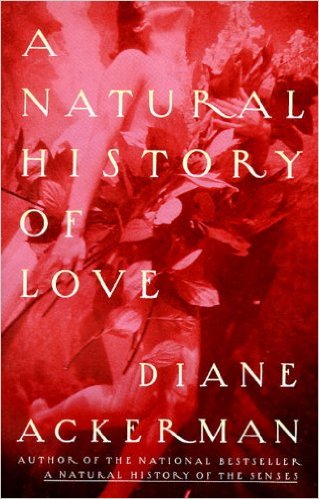
|
REVIEW
What makes Love; what chemistry; what brain wiring; what in the world is it, and why do we feel it. This book is not purely science; but more like scientific literature. Included in this exploration of Love is history, chemistry, psychology – all woven together by a superb story teller. Tons of little facts that make this such a fun read. Recommended.
SUMMARY
The bestselling author of A Natural History of the Senses now explores the allure of adultery, the appeal of aphrodisiacs, and the cult of the kiss. Enchantingly written and stunningly informed, this "audaciously brilliant romp through the world of romantic love" (Washington Post Book World) is the next best thing to love itself.
|
|
| 2 |
Ackerman, Diane
(2) |

|

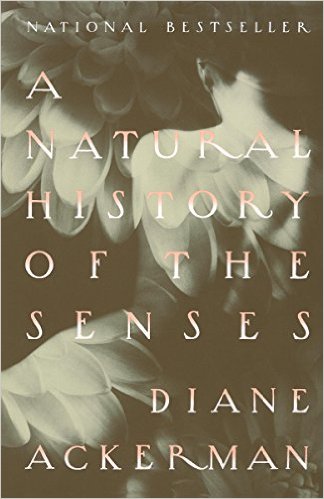
|
REVIEW
I don't know which of Ackerman's books I read first, but they are both delightful. Here she explores the way we sense the world around us. Again she weaves science and anecdote into a magical little volume that will fascinate you from start to finish (the section on vanilla alone makes the whole book worthwhile. Did you know that artificial vanilla is a by-product of making paper? And why real vanilla is so valuable?) Again, another fun read from this author.
SUMMARY
Diane Ackerman's lusciously written grand tour of the realm of the senses includes conversations with an iceberg in Antarctica and a professional nose in New York, along with dissertations on kisses and tattoos, sadistic cuisine and the music played by the planet Earth. "Delightful . . . gives the reader the richest possible feeling of the worlds the senses take in."--The New York Times. (Literature--Classics & Contemporary)
|
|
| 3 |
Baker, Robin
(1) |


|

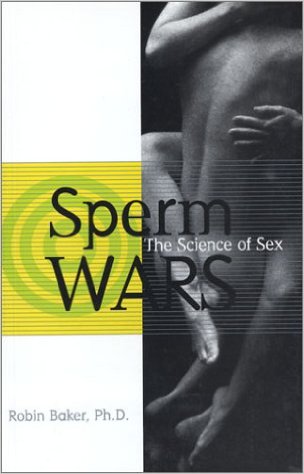
|
REVIEW
I used to think I knew how sex worked.. I'd gotten the usual education in high school, and I'd had years of practice. But until I read this book I had no clue what was really going on. When you read this it opens your eyes to a whole lot of things we humans do that we paint a veneer of conscious thought over.. but which is really governed by built-in sub-conscious and genetic systems evolved to keep the species going and to win the (literal) Sperm Wars!!! The writing style is a little hard - first he tells a story, then explains the subconscious motivations and the science behind the story. But it's a good introduction to this field for people that don't want to read a purely scientific tome.
This revolutionary book demonstrates that sexual behavior is driven by neither the psyche nor the conscious mind, but by biological imperatives programmed into us millions of years ago. Argues that a man's sexual behavior is based on the expectation that his sperm will have to compete with other men's sperm to fertilize the descending egg, & women are programmed to promote this sperm warfare. Uses a series of fictional scenes involving some form of sexual contact, followed by an interpretation of each scene from the viewpoint of an evolutionary biologist. Provides a strikingly original & fascinating window into sexual behavior.
SUMMARY
This revolutionary book demonstrates that sexual behavior is driven by neither the psyche nor the conscious mind, but by biological imperatives programmed into us millions of years ago. Argues that a man's sexual behavior is based on the expectation that his sperm will have to compete with other men's sperm to fertilize the descending egg, & women are programmed to promote this sperm warfare. Uses a series of fictional scenes involving some form of sexual contact, followed by an interpretation of each scene from the viewpoint of an evolutionary biologist. Provides a strikingly original & fascinating window into sexual behavior.
|
|
| 4 |
Bamford, James
(1) |

|

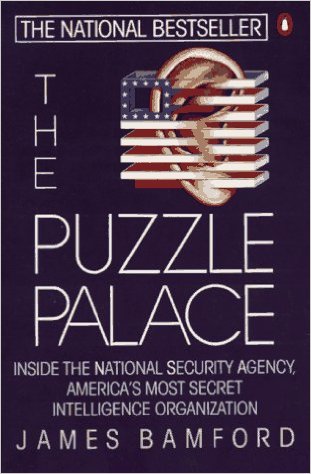
|
REVIEW
An interesting read into the capabilities of the NSA, what it is they do, and how they do it. I was reading this in Denmark, and knowing the the NSA uses computers to monitor calls to set off alarms I tried using various phrases to see if I could set off those alarms. Either I didn't, or I did and will never know. Anyway, an interesting read on one of the most secret organizations we have in this country.
In this remarkable tour de force of investigative reporting, James Bamford exposes the inner workings of America's largest, most secretive, and arguably most intrusive intelligence agency. The NSA has long eluded public scrutiny, but The Puzzle Palace penetrates its vast network of power and unmasks the people who control it, often with shocking disregard for the law. With detailed information on the NSA's secret role in the Korean Airlines disaster, Iran-Contra, the first Gulf War, and other major world events of the 80s and 90s, this is a brilliant account of the use and abuse of technological espionage.
SUMMARY
In this remarkable tour de force of investigative reporting, James Bamford exposes the inner workings of America's largest, most secretive, and arguably most intrusive intelligence agency. The NSA has long eluded public scrutiny, but The Puzzle Palace penetrates its vast network of power and unmasks the people who control it, often with shocking disregard for the law. With detailed information on the NSA's secret role in the Korean Airlines disaster, Iran-Contra, the first Gulf War, and other major world events of the 80s and 90s, this is a brilliant account of the use and abuse of technological espionage.
|
|
| 5 |
Barrows, Sydney Biddle
(1) |


|

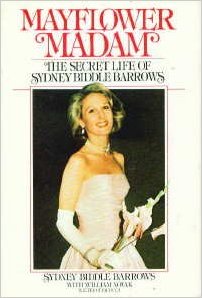
|
REVIEW
Well, the movie PRETTY WOMAN was fiction, but this is the real deal. How a Mayflower descendent managed to enter and then run a prostitution ring catering to some of the most up-scale clients in the world. Well written, and fun to read.
SUMMARY
With flair, humor, and style, Sydney Biddle Barrows tells the whole intriguing story of how she merged business and sex to create Cachet--the escort service of choice among rich, powerful, and prominent men. Adapting business management methods of the 1980s to the world's oldest profession, in this frank, surprising, and insightful, book, Ms. Barrows emerges as a woman who seized a chance and made the most of it.
|
|
| 6 |
Beiser, Vince
(1) |
|
The World in a Grain: The Story of Sand and How It Transformed Civilization(Fiction - General)

|


|
REVIEW
Who would have thought that we could be running out of sand. And yet, we are starting to. Sand, you see has to have special characteristics for different uses. Desert sand is no good for concrete, and so the Arabs have to import sand for construction. The sand for microchips comes from Spruce Pine, NC, USA (a place I used to vacation near and collect rocks from). People are being killed for sand. Beaches are losing sand, and folks try to replace it, but it is a losing battle.
Look around you.. All the glass you see uses sand. The building you are in needed sand. The road you drove on needs sand. The computer you are typing on used sand. This book is a remarkably interesting read on something we all take for granted.
SUMMARY
The gripping story of the most important overlooked commodity in the world--sand--and the crucial role it plays in our lives.
After water and air, sand is the natural resource that we consume more than any other--even more than oil. Every concrete building and paved road on Earth, every computer screen and silicon chip, is made from sand. From Egypt's pyramids to the Hubble telescope, from the world's tallest skyscraper to the sidewalk below it, from Chartres' stained-glass windows to your iPhone, sand shelters us, empowers us, engages us, and inspires us. It's the ingredient that makes possible our cities, our science, our lives--and our future.
And, incredibly, we're running out of it.
The World in a Grain is the compelling true story of the hugely important and diminishing natural resource that grows more essential every day, and of the people who mine it, sell it, build with it--and sometimes, even kill for it. It's also a provocative examination of the serious human and environmental costs incurred by our dependence on sand, which has received little public attention. Not all sand is created equal: Some of the easiest sand to get to is the least useful. Award-winning journalist Vince Beiser delves deep into this world, taking readers on a journey across the globe, from the United States to remote corners of India, China, and Dubai to explain why sand is so crucial to modern life. Along the way, readers encounter world-changing innovators, island-building entrepreneurs, desert fighters, and murderous sand pirates. The result is an entertaining and eye-opening work, one that is both unexpected and involving, rippling with fascinating detail and filled with surprising characters.
|
|
| 7 |
Blechman, Andrew D.
(1) |
|
Pigeons: The Fascinating Saga of the World's Most Revered and Reviled Bird(Science - General)


|


|
REVIEW
This was a vacation read, and it was fun. Did you know we know the exact date and time when the last Passenger Pigeon died; and who killed it. This is the only bird to ever receive military honors. And the myth about it being dirty.. well.. it's no dirtier than the one creature if follows everywhere. Man.
This is a fun little light read. Take it on vacation with you.
SUMMARY
Pigeons have been worshipped as fertility goddesses and revered as symbols of peace. Domesticated since the dawn of man, they've been used as crucial communicators in war by every major historical superpower from ancient Egypt to the United States and are credited with saving thousands of lives. Charles Darwin relied heavily on pigeons to help formulate and support his theory of evolution. Yet today they are reviled as "rats with wings." Author Andrew D. Blechman traveled across the United States and Europe to meet with pigeon fanciers and pigeon haters in a quest to find out how we came to misunderstand one of mankind's most helpful and steadfast companions. Pigeons captures a Brooklyn man's quest to win the Main Event (the pigeon world's equivalent of the Kentucky Derby), as well as a convention dedicated to breeding the perfect bird. Blechman participates in a live pigeon shoot where entrants pay $150; he tracks down Mike Tyson, the nation's most famous pigeon lover; he spends time with Queen Elizabeth's Royal Pigeon Handler; and he sheds light on a radical "pro-pigeon underground' in New York City. In Pigeons, Blechman tells for the first time the remarkable story behind this seemingly unremarkable bird.
|
|
| 8 |
Bloom, Howard
(1) |

|

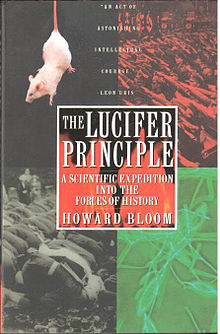
|
REVIEW
This book tries to show that "evil" is not some force living outside of human nature, but is an integral part of human nature - that evil is built into our genes. Actions many consider evil can be explained in evolutionary terms (see previous comments on racism). This books examines human history against human nature. How our genes drive us to conflict - and why. How memes can take hold in a society looking for resources. It scales up individual foibles to societal foibles - and not to unconvincingly. I did a lot of writing in this book. Always a good sign.
SUMMARY
The Lucifer Priciple is a revolutionary work that explores the intricate relationships among genetics, human behavior, and culture to put forth the thesis that "evil" is a by-product of nature's strategies for creation and that it is woven into our most basic biological fabric.
In a sweeping narrative that moves lucidly among sophisticated scientific disciplines and covers the entire span of the earth's, as well as mankind's, history, Howard Bloom challenges some of our most popular scientific assumptions. Drawing on evidence from studies of the most primitive organisms to those on ants, apes, and humankind, the author makes a persuasive case that it is the group, or "superorganism," rather than the lone individual that really matters in the evolutionary struggle. But, Bloom asserts, the prominence of society and culture does not necessarily mitigate against our most violent, aggressive instincts. In fact, under the right circumstances the mentality of the group will only amplify our most primitive and deadly urges.
In Bloom's most daring contention he draws an analogy between the biological material whose primordial multiplication began life on earth and the ideas, or "memes," that define, give cohesion to, and justify human superorganisms. Some of the most familiar memes are utopian in nature—Christianity or Marxism; nonetheless, these are fueled by the biological impulse to climb to the top of the heirarchy. With the meme's insatiable hunger to enlarge itself, we have a precise prescription for war.
Biology is not destiny; but human culture is not always the buffer to our most primitive instincts we would like to think it is. In these complex threads of thought lies the Lucifer Principle, and only through understanding its mandates will we able to avoid the nuclear crusades that await us in the twenty-first century.
|
|
| 9 |
Boukreev , Anatoli
(1) |

|

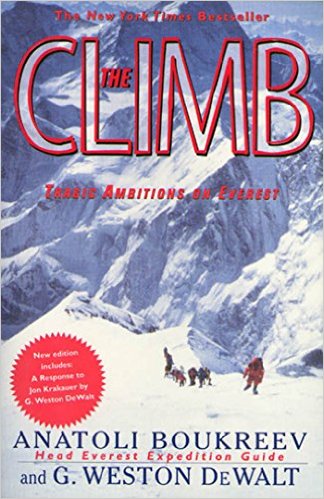
|
REVIEW
If you heard of the book, Into Thin Air, this is Boukreev's account of the 1996 Mount Everest expeditions that resulted in the deaths of eight people. Apparently the first book painted Boukreev as careless with his client's safety. Near as I can tell, EVERYONE was careless about safety. You would think that the people who put these climbs together would have a little more forethought, but nope. No rules, No guidelines. No plan. Nada. They couldn't communicate, and they thought that if they played it by ear everything would be ok. Well, everything turned to S**T pretty damn fast, and there was nothing anyone could do to save the people who died. Boukreev seems to be one of the few who made an effort at rescue - though, from the reading, if others had attempted to assist him they too would probably have died. What I found amazing was the fact that, once you are dead on the mountain, it owns you. At one point they come across a body on a clear day and an easy slope. No attempt to identify who it is or remove it. If you die on Everest, you stay on Everest (which makes the name seem much more appropriate.) And death comes easy. All I can say is, if you ever find yourself attempting to summit Everest and you can't make the top by 2 o'clock... TURN BACK or you are pretty much dead.
SUMMARY
In May 1996 three expeditions attempted to climb Mount Everest on the Southeast Ridge route pioneered by Sir Edmund Hillary and Tenzing Norgay in 1953. Crowded conditions slowed their progress. Late in the day twenty-three men and women-including expedition leaders Scott Fischer and Rob Hall-were caught in a ferocious blizzard. Disoriented and out of oxygen, climbers struggled to find their way down the mountain as darkness approached. Alone and climbing blind, Anatoli Boukreev brought climbers back from the edge of certain death. This new edition includes a transcript of the Mountain Madness expedition debriefing recorded five days after the tragedy, as well as G. Weston DeWalt's response to Into Thin Air author Jon Krakauer.
|
|
| 10 |
Burnham, Jay
(1) |
|
Mean Genes: From Sex To Money To Food; Taming Our Primal Instincts(Science - Evolutionary Psychology)

|

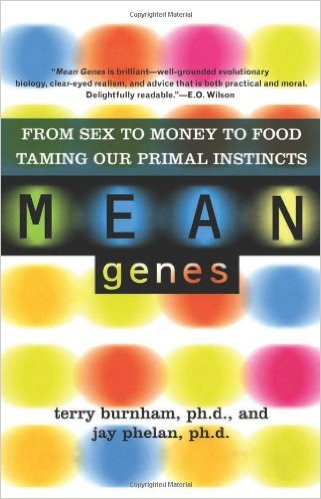
|
REVIEW
Another book on how genetics affect behavior. Nothing really new in this one, and written in kind of a pop style, but good for someone who does not want to read the heavier stuff I have listed here. A little anecdotal, but obviously based on a collection of research. Has a set of notes on-line that looks interesting www.meangenes.org
Why do we want—and why do we do—so many things that are bad for us? And how can we stop? In Mean Genes economist Terry Burnham and biologist Jay Phelan offer advice on how to conquer our own worst enemy—our survival-minded genes. Having evolved in a time of scarcity, when our ancestors struggled to survive in the wild, our genes are poorly adapted to the convenience of modern society. They compel us to overeat, spend our whole paycheck, and cheat on our spouses. But knowing how they work, Burnham and Phelan show that we can trick these "mean genes" into submission and cultivate behaviors that will help us lead better lives. A lively, humorous guide to our evolutionary heritage, Mean Genes illuminates how we can use an understanding of our biology to beat our instincts—before they beat us.
SUMMARY
Why do we want—and why do we do—so many things that are bad for us? And how can we stop? In Mean Genes economist Terry Burnham and biologist Jay Phelan offer advice on how to conquer our own worst enemy—our survival-minded genes. Having evolved in a time of scarcity, when our ancestors struggled to survive in the wild, our genes are poorly adapted to the convenience of modern society. They compel us to overeat, spend our whole paycheck, and cheat on our spouses. But knowing how they work, Burnham and Phelan show that we can trick these "mean genes" into submission and cultivate behaviors that will help us lead better lives. A lively, humorous guide to our evolutionary heritage, Mean Genes illuminates how we can use an understanding of our biology to beat our instincts—before they beat us.
|
|
| 11 |
Buss, David M.
(1) |
|
The Evolution of Desire: Strategies of Human Mating(Science - Evolutionary Psychology)


|

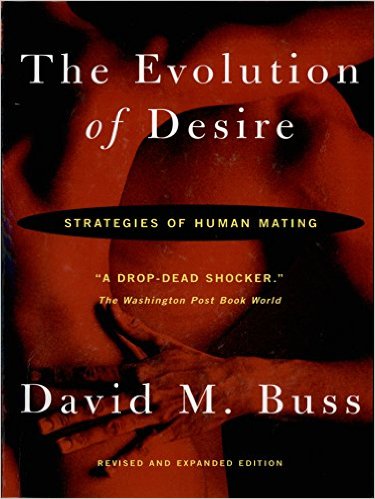
|
REVIEW
This book was very interesting in terms of how various aspects of the way men and women get along today are affected by what went on during evolution. One of the most interesting stories.. and most amusing.. was the story about the Coolidge Effect. This is the effect noted in most men that your steady partner tends to become less attractive sexually over time. You know the old puns about sex before the marriage versus after; put a marble in the jar every time you have sex before you are married, and take one out of the jar each time you make love after you are married and you'll never empty the jar in the same time it took to fill it. Sexual desire for the same partner fades over time. But put a NEW partner in and sexual desire will immediately jump to it's old levels. If your a man you know EXACTLY what I am talking about. It's been documented to occur in other mammal species as well. Disguising the normal partner has no effect (sorry, gals.. the old saw about dressing up in lingerie when he comes home from work .. well.. it might work once.. but won't work steady). Anyway.. the story goes that President and Mrs. Coolidge were visiting a WPA Farm one day when the First Lady saw a rooster servicing a hen. She commented on it, and the farm hand said something like, "Oh he does that 20 times a day!". The First Lady thought this was amusing so she said that the farm hand should be sure to relay this information to the President when he came by.
When President Coolidge came by the farm hand told him about the rooster's accomplishments sexually and that the First Lady asked to have that passed on. "20 times a day you say. Always with the same hen? "Oh no, sir. A different one each time." "Would you please relay THAT fact to the First Lady." And thus the name for this aspect of human sexuality was given a name... The Coolidge Principle.
With two new chapters by the author.If we all want love, why is there so much conflict in our most cherished relationships? To answer this question, says noted psychologist David Buss, we must look into our evolutionary past. Based on the most massive study of human mating ever undertaken, encompassing more than ten thousand people of all ages from thirty-seven cultures worldwide, The Evolution of Desire is the first book to present a unified theory of human mating behavior. Now in a revised and updated edition, Buss's classic presents the latest research in the field, including startling new discoveries about the evolutionary advantages of infidelity, orgasm, and physical attractiveness.
SUMMARY
With two new chapters by the author.If we all want love, why is there so much conflict in our most cherished relationships? To answer this question, says noted psychologist David Buss, we must look into our evolutionary past. Based on the most massive study of human mating ever undertaken, encompassing more than ten thousand people of all ages from thirty-seven cultures worldwide, The Evolution of Desire is the first book to present a unified theory of human mating behavior. Now in a revised and updated edition, Buss's classic presents the latest research in the field, including startling new discoveries about the evolutionary advantages of infidelity, orgasm, and physical attractiveness.
|
|
| 12 |
Canfield, Jack
(1) |
|
The Aladdin Factor(Instructional)


|

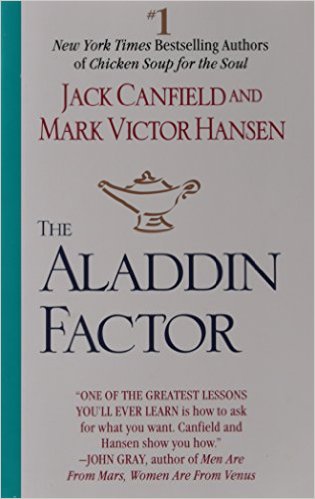
|
REVIEW
This little book...... is simply amazing. It teaches you how to ASK FOR WHAT YOU WANT. Which is something we all forget we have to DO in order to GET WHAT WE WANT? It's simple to read and will open your eyes to things possible that you never thought of before. It's written mostly for sales people, but the lessons apply to all of us. If you want something you need to ask for it. What stops you from asking for what you want? Lots of things. Most of the book teaches you how to get around the issues we all have that stop us from asking for what we want.
SUMMARY
Anything is possible...if you dare to ask!
Personal happiness. Creative fulfillment. Professional success. Freedom from fear--and a new promise of joy that's yours for the asking.
We have the ability at our fingertips to achieve these things. It's the Aladdin Factor: the magical wellspring of confidence, desire--and the willingness to ask--that allows us to make wishes come true. Now bestselling motivational authors Jack Canfield and Mark Victor Hansen introduce us to the Aladdin Factor--and help us put it into effect in our own lives.
|
|
| 13 |
Carroll, Sean B.
(1) |
|
The Making of the Fittest: DNA and the Ultimate Forensic Record of Evolution(Science - Evolutionary Psychology)


|

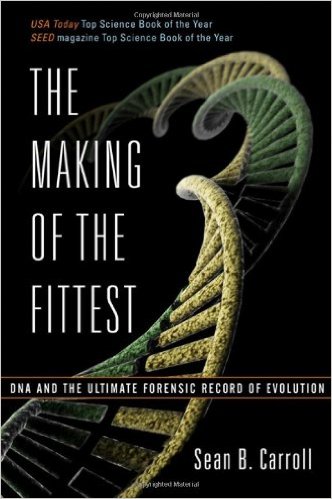
|
REVIEW
What a great book! Hand this to the next creationist you come across. Basically, we don't need ANY fossil record to prove evolution. Gaps in the fossil record!! Who cares. We have the proof of evolution inside every cell of our bodies. Our DNA proves that evolution happened, and that it is still happening. It provides the time line. It provides the family line. Everything you need to see how evolution works is right there in the DNA. You don't need a single fossil to prove this theory (indeed, Darwin didn't look at fossils to come up with the theory in the first place). There is some mathematics involved, but its pretty simple statistical analysis to understand how things will change over time and a bit of probability. But there is nothing esoteric in this that is beyond the comprehension of the average high schooler. Like I said... Hand this book to the next creationist spouting off about the fossil record.
DNA evidence not only solves crimes?in Sean Carroll's hands it will now end the Evolution Wars.
DNA, the genetic blueprint of all creatures, is a stunningly rich and detailed record of evolution. Every change or new trait, from the gaudy colors of tropical birds to our color vision with which we admire them, is due to changes in DNA that leave a record and can be traced. Just as importantly, the DNA evidence has revealed several profound surprises about how evolution actually works.
SUMMARY
DNA evidence not only solves crimes?in Sean Carroll's hands it will now end the Evolution Wars.
DNA, the genetic blueprint of all creatures, is a stunningly rich and detailed record of evolution. Every change or new trait, from the gaudy colors of tropical birds to our color vision with which we admire them, is due to changes in DNA that leave a record and can be traced. Just as importantly, the DNA evidence has revealed several profound surprises about how evolution actually works. 50 black-and-white illustrations and 8 pages of color
|
|
| 14 |
Carville, James
(1) |
|
Had Enough?: A Handbook for Fighting Back(Politics)

|

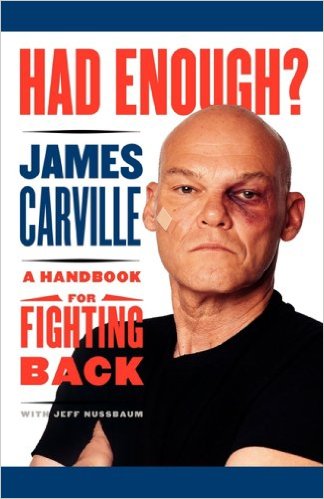
|
REVIEW
This book came out before the 2004 election and was a wake up call to democrats on how to fight the republicans on their own political turf. Of course, never letting an opportunity to snatch defeat from the jaws of victory, the democrats ran their typical wishy washy campaign, and lost. To bad they didn't read this book. It would still help today. Every liberal should read this to see how to take back dominance in all the issues we have lost. Yes, liberals can lead, but they have to show some B**LS to do it.
SUMMARY
Have you had enough of George W. Bush and the Republican right? Are you sick and tired of the tax-cutting, environment-desecrating, secret-keeping, influence-peddling, war-mongering, free speech-hating hypocrites who occupy America's halls of power? If so, you have company -- James Carville.
Like James Carville, America has been bruised and battered by the Republicans who are running our country and running it into the ground. The Bush administration has squandered a five-trillion-dollar surplus and created a five-trillion-dollar projected deficit. Their tax cut for the rich was supposed to create jobs -- but instead America has lost more than three million of them. This administration was supposed to bring honor and dignity to the White House but instead brought lies, leaks, secrecy, and fear. They promised to make the country stronger and safer but instead they've left us overstretched, isolated, and insecure.
And Carville has had enough.
In Had Enough? the legendary political adviser comes out of his corner swinging, taking on the Bush White House and the Republican leaders in Congress on every front -- from the economy to education to foreign affairs. But he doesn't just attack; he lays out constructive "had enough" solutions for healing the damage done by the Republicans and helping disheartened Democrats get back on their feet. In addition, he offers "Ten Rules for Progressives to Live By" and a new War Room mantra for a new era.
Had Enough? is a rousing handbook for taking back the country, for fighting back the right wing, and for returning the power to the people.
|
|
| 15 |
Cialdini, Robert B.
(1) |
|
Influence: The Psychology of Persuasion(Psychology)

|


|
REVIEW
An interesting read. Very anecdotal and fun.
Want to learn how to influence someone.. it's in here.
SUMMARY
Influence, the classic book on persuasion, explains the psychology of why people say "yes"—and how to apply these understandings. Dr. Robert Cialdini is the seminal expert in the rapidly expanding field of influence and persuasion. His thirty-five years of rigorous, evidence-based research along with a three-year program of study on what moves people to change behavior has resulted in this highly acclaimed book.
You'll learn the six universal principles, how to use them to become a skilled persuader—and how to defend yourself against them. Perfect for people in all walks of life, the principles of Influence will move you toward profound personal change and act as a driving force for your success.
|
|
| 16 |
Courland, Robert
(1) |
|
Concrete Planet: The Strange and Fascinating Story of the World's Most Common Man-Made Material(Science - General)

|


|
REVIEW
Pretty amazing that concrete was discovered so early in human history - considering how hard it is to actually make. However, be that as it may, concrete has had a very inconsistent history. The Romans used it extensively - and built one of the most amazing concrete structures in history - the Pantheon. And even more amazing... We, today, cannot achieve what the Romans managed because every thing we do, is going to fall apart.. and very soon. Concrete buildings, bridges and roads built today will last.. 50, maybe 70 years - before they have to be torn down and rebuilt. Why? Rust. We build with reinforced concrete.. that simply will not last. We live in a temporary world. The Pantheon has not rebar.. it is pure concrete, of a type no longer used. And yet is has lasted 2000 years. We can't even imagine a building we make now lasting that long. We just don't know how to do it.
That is just one of the lessons in this book. I would not recommend this to most people, but there is some good information in here. If you are an engineer and history buff, then this might be for you.
SUMMARY
Concrete: We use it for our buildings, bridges, dams, and roads. We walk on it, drive on it, and many of us live and work within its walls. But very few of us know what it is. We take for granted this ubiquitous substance, which both literally and figuratively comprises much of modern civilization?s constructed environment; yet the story of its creation and development features a cast of fascinating characters and remarkable historical episodes. This book delves into this history, opening readers? eyes at every turn.
In a lively narrative peppered with intriguing details, author Robert Corland describes how some of the most famous personalities of history became involved in the development and use of concrete?including King Herod the Great of Judea, the Roman emperor Hadrian, Thomas Edison (who once owned the largest concrete cement plant in the world), and architect Frank Lloyd Wright. Courland points to recent archaeological evidence suggesting that the discovery of concrete directly led to the Neolithic Revolution and the rise of the earliest civilizations. Much later, the Romans reached extraordinarily high standards for concrete production, showcasing their achievement in iconic buildings like the Coliseum and the Pantheon. Amazingly, with the fall of the Roman Empire, the secrets of concrete manufacturing were lost for over a millennium.
The author explains that when concrete was rediscovered in the late eighteenth century it was initially viewed as an interesting novelty or, at best, a specialized building material suitable only for a narrow range of applications. It was only toward the end of the nineteenth century that the use of concrete exploded. During this rapid expansion, industry lobbyists tried to disguise the fact that modern concrete had certain defects and critical shortcomings. It is now recognized that modern concrete, unlike its Roman predecessor, gradually disintegrates with age. Compounding this problem is another distressing fact: the manufacture of concrete cement is a major contributor to global warming.
Concrete Planet is filled with incredible stories, fascinating characters, surprising facts, and an array of intriguing insights into the building material that forms the basis of the infrastructure on which we depend.
|
|
| 17 |
Davies, Pete
(1) |
|
The Devil's Flu: The World's Deadliest Influenza Epidemic and the Scientific Hunt for the Virus That Caused It(Science - General)


|

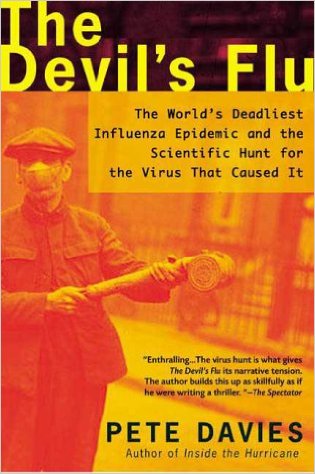
|
REVIEW
If this book doesn't scare the heck out of you, nothing will. The world was nearly destroyed at the start of the last century by a flu pandemic that killed 3 out of ever 10 people on the planet. In fact, the biggest killer in the last century was - not Stalin - not Hitler - not all the wars combined - It was flu. Don't believe me.. read this book and be afraid. And keep in the back of your mind that we are due for another... any day now.
A gripping account of the 1918 flu pandemic and the modern-day hunt for this elusive and deadly virus
In 1918, a flu virus more lethal than any that has come along since swept through the world, from the remotest villages in Arctic climates to crowded U.S.cities to the battlefields of Europe, killing forty million people. Yet, despite its devastating toll and the probability that other deadly pandemics await on the horizon, it was relegated to a footnote in history. The Devil's Flu is the extraordinary story of 1918's forgotten tragedy and of the global scientific community's effort to avert another such disaster.
The 1918 flu still so intrigues and frightens experts in the field that in 1998, a group of respected scientists journeyed to the Norwegian Arctic Circle in search of the mysterious killer. In The Devil's Flu, Davies captures the excitement of the hunt and the intense rivalries within the scientific community, and paints a vivid portrait of the eccentric scientists bent on capturing the prize information that could hold the key to our future safety. And as far as the next pandemic is concerned, scientists agree: it's not a question of if, but when.
SUMMARY
A gripping account of the 1918 flu pandemic and the modern-day hunt for this elusive and deadly virus
In 1918, a flu virus more lethal than any that has come along since swept through the world, from the remotest villages in Arctic climates to crowded U.S.cities to the battlefields of Europe, killing forty million people. Yet, despite its devastating toll and the probability that other deadly pandemics await on the horizon, it was relegated to a footnote in history. The Devil's Flu is the extraordinary story of 1918's forgotten tragedy and of the global scientific community's effort to avert another such disaster.
The 1918 flu still so intrigues and frightens experts in the field that in 1998, a group of respected scientists journeyed to the Norwegian Arctic Circle in search of the mysterious killer. In The Devil's Flu, Davies captures the excitement of the hunt and the intense rivalries within the scientific community, and paints a vivid portrait of the eccentric scientists bent on capturing the prize information that could hold the key to our future safety. And as far as the next pandemic is concerned, scientists agree: it's not a question of if, but when.
|
|
| 18 |
Dawkins, Richard
(1) |



|

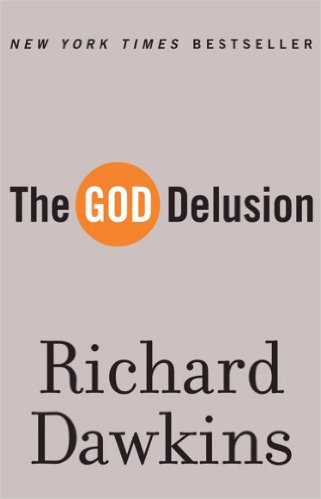
|
REVIEW
Richard Dawkins doing the same thing Sam Harris did in the End Of Faith, only Mr. Harris did it much better. Dawkins, though, is a bit of a story teller, and that makes this interesting. As a respected scientist, he is often button holed on his thoughts on God and religion, and he has no qualms about saying, if you can't measure it, if you can even postulate a testable theory, then its not worth the time of day to discuss. Just replace the word "GOD" with "FLYING SPAGHETTI MONSTER" and you come up with something that makes just as much sense.
Read Harris first and this one if you just want more.
SUMMARY
A preeminent scientist -- and the world's most prominent atheist -- asserts the irrationality of belief in God and the grievous harm religion has inflicted on society, from the Crusades to 9/11.
With rigor and wit, Dawkins examines God in all his forms, from the sex-obsessed tyrant of the Old Testament to the more benign (but still illogical) Celestial Watchmaker favored by some Enlightenment thinkers. He eviscerates the major arguments for religion and demonstrates the supreme improbability of a supreme being. He shows how religion fuels war, foments bigotry, and abuses children, buttressing his points with historical and contemporary evidence. The God Delusion makes a compelling case that belief in God is not just wrong but potentially deadly. It also offers exhilarating insight into the advantages of atheism to the individual and society, not the least of which is a clearer, truer appreciation of the universe's wonders than any faith could ever muster.
|
|
| 19 |
Delavier, Frederic
(1) |
|
Strength Training Anatomy(Instructional)


|

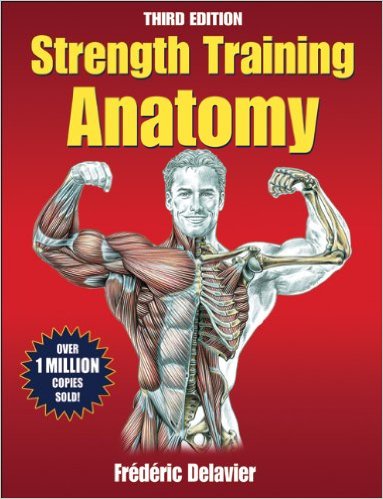
|
REVIEW
I got into lifting weights a few years ago. I had a work out partner and we just used to wing it. Later, I wanted to know what to do to work specific areas and to avoid injuring myself. I found this book, and it is the best I have ever seen. The diagrams make everything clear. The instructions are complete. And, probably best of all, almost everything is done with free weights. Any gym will have what you need to do these exercises. You don't have to worry if they don''t have a particular machine, they will have the equipment you need to use this book.
I highly recommend this book.
SUMMARY
With new exercises, additional stretches, and more of Frédéric Delavier's signature illustrations, you'll gain a whole new understanding of how muscles perform during strength exercises. This one-of-a-kind best-seller combines the visual detail of top anatomy texts with the best of strength training advice.
Many books explain what muscles are used during exercise, but no other resource brings the anatomy to life like Strength Training Anatomy. Over 600 full-color illustrations reveal the primary muscles worked along with all the relevant surrounding structures, including bones, ligaments, tendons, and connective tissue.
Like having an X-ray for each exercise, the anatomical depictions show both superficial and deep layers and detail how various setup positions affect muscle recruitment and emphasize underlying structures. New pages show common strength training injuries in a fascinating light and offer precautions to help you exercise safely.
|
|
| 20 |
Dell, Dianna
(1) |
|
The PMDD Phenomenon(Science - General)

|


|
REVIEW
PMS... the bane of everyone's existence. But, what if it is more. This book talks about regular PMS and beyond. I read it trying to understand what my wife was going through every month, and how I could live with it. I'm giving this 3 stars because it is well written, but I only recommend it to women (and men) who think they might be living with MORE than normal PMS.
The first book to clearly explain this new disorder and offer treatment options
Afflicting an estimated 3 million women in the United States, PMDD is an extreme form of PMS in which the physical and psychological symptoms are often so severe that they strain social, familial, and work relationships to the breaking point. Despite the rapidly growing body of scientific research into its causes and cures, PMDD continues to be a bone of contention among medical professionals, and many women who suffer from it are still told that it's all in their heads. The first consumer book written on this condition and authored by a nationally respected expert on the treatment of this condition, The PMDD Phenomenon:
Helps readers determine whether they have PMDD
Explains the full spectrum of prescription and nonprescription drug therapies
Covers major alternative treatments
Features inspiring and informative case studies of women who have battled PMDD
SUMMARY
The first book to clearly explain this new disorder and offer treatment options
Afflicting an estimated 3 million women in the United States, PMDD is an extreme form of PMS in which the physical and psychological symptoms are often so severe that they strain social, familial, and work relationships to the breaking point. Despite the rapidly growing body of scientific research into its causes and cures, PMDD continues to be a bone of contention among medical professionals, and many women who suffer from it are still told that it's all in their heads. The first consumer book written on this condition and authored by a nationally respected expert on the treatment of this condition, The PMDD Phenomenon:
Helps readers determine whether they have PMDD
Explains the full spectrum of prescription and nonprescription drug therapies
Covers major alternative treatments
Features inspiring and informative case studies of women who have battled PMDD
|
|
| 21 |
Doughty, Caitlin
(1) |
|
Will My Cat Eat My Eyeballs?: And Other Questions About Dead Bodies(Science - General)

|

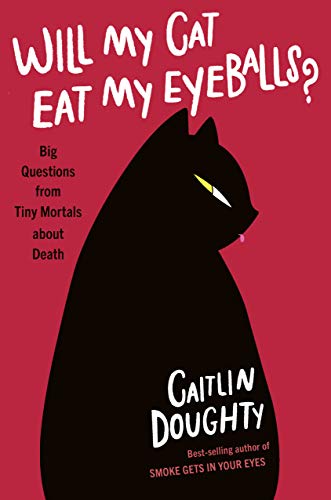
|
REVIEW
Caitlyn Doughty is a mortician who runs a YOUTUBE channel that answers questions people ask (and questions they don't want to ask) about death, dead bodies, and death ceremonies. I love her videos and this book was amusing. It's mostly kid's questions about death and what happens to your body after you die. There is information in here you did not know. There is information here that maybe you didn't want to know (of face it, you really do). Fun.
SUMMARY
New York Times Bestseller
Winner of a Goodreads Choice Award
“Funny, dark, and at times stunningly existential.” —Marianne Eloise, Guardian
Everyone has questions about death. In Will My Cat Eat My Eyeballs?, best-selling author and mortician Caitlin Doughty answers the most intriguing questions she’s ever received about what happens to our bodies when we die. In a brisk, informative, and morbidly funny style, Doughty explores everything from ancient Egyptian death rituals and the science of skeletons to flesh-eating insects and the proper depth at which to bury your pet if you want Fluffy to become a mummy. Now featuring an interview with a clinical expert on discussing these issues with young people—the source of some of our most revealing questions about death—Will My Cat Eat My Eyeballs? confronts our common fear of dying with candid, honest, and hilarious facts about what awaits the body we leave behind.
|
|
| 22 |
Durant, Will
(2) |

|

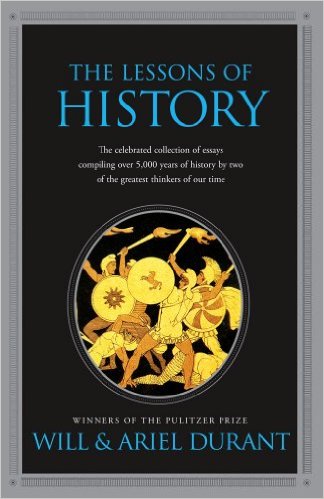
|
REVIEW
This is Will Durant's summary to the ten volume set of his history. All the lessons learned from mankind while creating his great work are summed up here – and we are doomed to repeat them over and over – so it seems.
A concise survey of the culture and civilization of mankind, The Lessons of History is the result of a lifetime of research from Pulitzer Prize–winning historians Will and Ariel Durant.
With their accessible compendium of philosophy and social progress, the Durants take us on a journey through history, exploring the possibilities and limitations of humanity over time. Juxtaposing the great lives, ideas, and accomplishments with cycles of war and conquest, the Durants reveal the towering themes of history and give meaning to our own.
SUMMARY
In this illuminating and thoughtful book, Will and Ariel Durant have succeeded in distilling for the reader the accumulated store of knowledge and experience from their four decades of work on the ten monumental volumes of The Story of Civilization. The result is a survey of human history, full of dazzling insights into the nature of human experience, the evolution of civilization, the culture of man. With the completion of their life's work they look back and ask what history has to say about the nature, the conduct and the prospects of man, seeking in the great lives, the great ideas, the great events of the past for the meaning of man's long journey through war, conquest and creation -- and for the great themes that can help us to understand our own era.
To the Durants, history is "not merely a warning reminder of man's follies and crimes, but also an encouraging remembrance of generative souls...a spacious country of the mind, wherein a thousand saints, statesmen, inventors, scientists, poets, artists, musicians, lovers, and philosophers still live and speak, teach and carve and sing...."
Designed to accompany the ten-volume set of The Story of Civilization, The Lessons of History is, in its own right, a profound and original work of history and philosophy.
|
|
| 23 |
Durant, Will
(2) |


|

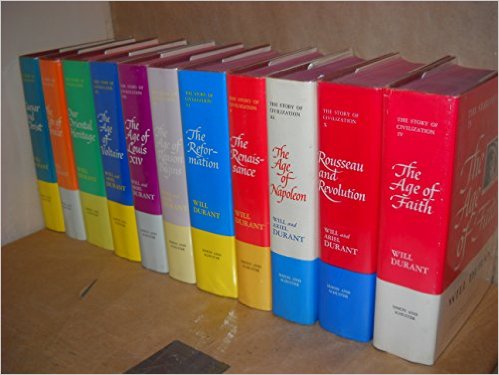
|
REVIEW
I had a job once that involved lots of alone time with not much to do. I read 8 volumes of this and am so glad I did. (To confess I did skip a short section on Roman Law.. it didn't look all that interesting.) Will Durant's style is entertaining and informative. Certain things from these books will stick for life. It is great to get the full sweep of history from such a scholar. I completely recommend these books.
SUMMARY
The Durants strove throughout The Story of Civilization to create what they called "integral history". They opposed this to the "specialization" of history, an anticipatory rejection of what some have called the "cult of the expert". Their goal was to write a "biography" of a civilization, in this case, the West, including not just the usual wars, politics and biography of greatness and villainy, but also the culture, art, philosophy, religion, and the rise of mass communication. Much of The Story considers the living conditions of everyday people throughout the 2,500 years their "story" of the west covers. They also bring an unabashedly moral framework to their accounts, constantly stressing the repetition of the "dominance of strong over the weak, the clever over the simple". The Story of Civilization is the most successful historiographical series in history. It has been said that the series "put Simon & Schuster on the map" as a publishing house. An unabridged audiobook production of all 11 volumes was produced by Books On Tape Inc. and was read by Alexander Adams (aka Grover Gardner).
The Story of Civilization is also noteworthy because of the excellence of its writing style, and contains numerous adages worthy of the Roman and Renaissance authors Durant admired. Discussing certain inconsistencies in the character of Botticelli in The Renaissance (p. 137), he writes: "Doubtless like all of us he was many men, turned on one or another of his selves as occasion required, and kept his real self a frightened secret from the world."
For Rousseau and Revolution (1967), the 10th volume of The Story of Civilization, the Durants were awarded the Pulitzer Prize for literature. In 1977 this was followed by one of the two highest awards granted by the United States government to civilians, the Presidential Medal of Freedom, awarded by President Ford.
The first volume of The Story of Civilization series, called Our Oriental Heritage (1935), is divided into an introduction and three books. The introduction takes the reader through the different aspects of civilization (economical, political, moral and mental). Book One is dedicated to the civilizations of the Near East (Sumeria, Egypt, Babylonia, Assyria, Judea and Persia). Book two is "India and Her Neighbors". Book three moves deeper into the east, where the Chinese Civilization flourishes and where Japan starts to find its place in the world's political map.
|
|
| 24 |
Easton, Dossie
(1) |

|

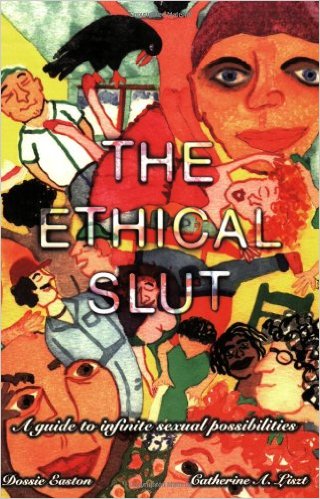
|
REVIEW
It is possible to have new kinds of relationships in a post evolutionary world. This is a book about Polyamoury – relationships that involve more than two people and how to make them work.
SUMMARY
The essential guide for singles and couples who want to explore polyamory in ways that are ethically and emotionally sustainable.
For anyone who has ever dreamed of love, sex, and companionship beyond the limits of traditional monogamy, this groundbreaking guide navigates the infinite possibilities that open relationships can offer. Experienced ethical sluts Dossie Easton and Janet W. Hardy dispel myths and cover all the skills necessary to maintain a successful and responsible polyamorous lifestyle--from self-reflection and honest communication to practicing safe sex and raising a family. Individuals and their partners will learn how to discuss and honor boundaries, resolve conflicts, and to define relationships on their own terms.
"I couldn't stop reading it, and I for one identify as an ethical slut. This is a book for anyone interested in creating more pleasure in their lives . . . a complete guide to improving any style of relating, from going steady to having an extended family of sexual friends." --Betty Dodson, PhD, author of Sex for One
|
|
| 25 |
Ferris, Timothy
(1) |


|

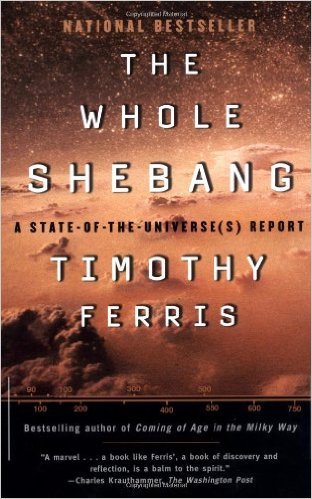
|
REVIEW
I have always been interested in physics and the big bang. This book explains it all better than anything I have ever read on the subject. Yes, it's a deep subject, and requires some patience and background knowledge (you should at least be aware of what relativity means). But with the anecdotes about physicists and their lives mixed in with the latest theories on the big bang (inflation is in here too.. ) this book is my top recommendation on this subject. I loved it. It covers one of the most interesting new aspects of cosmology around.. the INFLATION theory of the Big Bang. Apparently, shortly after the Big Bang occurred, something (some mysterious force) caused the expansion of the universe to speed up even faster than it would have just given the strength of the initial bang. The time frames we talking about are in the nano-seconds, but this inflation at the very start of the universe explains some of the strange observation
From the prizewinning author who has been called "the greatest science writer in the world" comes this delightfully comprehensive and comprehensible report on how science today envisions the universe as a whole.
Timothy Ferris provides a clear, elegantly written overview of current research and a forecast of where cosmological theory is likely to go in the twenty-first century. He explores the questions that have occurred to even casual readers -- who are curious about nature on the largest scales: What does it mean to say that the universe is "expanding," or that space is "curved"? -- and sheds light on the possibility that our universe is only one among many universes, each with its own physical laws and prospects for the emergence of life.
SUMMARY
Timothy Ferris provides a clear, elegantly written overview of current research and a forecast of where cosmological theory is likely to go in the twenty-first century. He explores the questions that have occurred to even casual readers -- who are curious about nature on the largest scales: What does it mean to say that the universe is "expanding," or that space is "curved"? -- and sheds light on the possibility that our universe is only one among many universes, each with its own physical laws and prospects for the emergence of life
|
|
| 26 |
Fields, Rick
(1) |
|
Chop Wood, Carry Water(Spirituality)

|

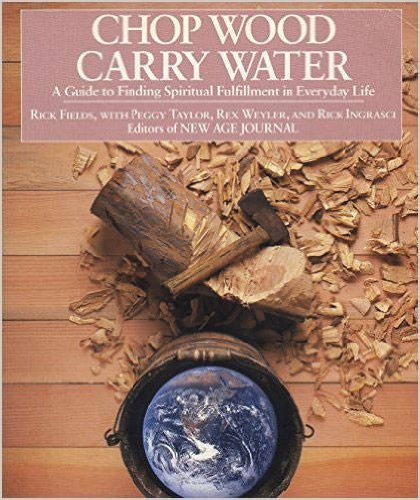
|
REVIEW
So how do you go about integrating a spiritual life into the lives we live now. This book will tell you. The title is based on a Buddhist proverb that goes: Before Enlightenment, Chop Wood, Carry water. After Enlightenment, Chop Wood, Carry Water. Which is trying to say that you live in this world, and as long as you do, you have to get the basics done, no matter HOW spiritually in-tune you are? It's a very enjoyable read.
SUMMARY
The message is as true today as it was then: the greatest lessons and the profoundest heights of the spiritual path can be found in our everyday life. It is the greatest challenge for people living in contemporary society to find the spiritual aspects of working in an office, store, or factory; balancing a checkbook; raising a family; or making a relationship work. How can we make all these daily activities a part of the path? How can we apply the insights of great spiritual traditions, and our own experience, to the way we live and develop?
This book is a guide - a handbook filled with information, advice, hints, stories, inspiration, encouragement, connections, warning, and cautions, for the inner journey as we live throughout our lives.
Chop Wood, Carry Water contains much ancient wisdom, but the emphasis is on contemporary perceptions. Many of our guides have been known to humanity for millennia: they are the world's great spiritual teachers- Christ, the Buddha, Loa Tse, Confucius. Others are contemporary teacher and healers, widely recognized and respected. All offer ways to integrate the events, our focus on relationships and family, our struggle with technology, money, politics and more- into the quest for spiritual fulfillment.
|
|
| 27 |
Foster, Thomas
(2) |


|

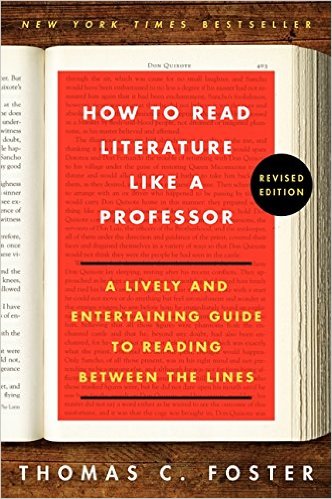
|
REVIEW
This is a great book. It makes it clear that some things in any bit of literature have meaning and when you see them it clues you in to look for that meaning. Examples? The weather - no author is going to write about weather in a book unless it is serving a purpose. Physical deformities - These always have a meaning, otherwise, why include them (Harry Potter's scar for instance). Journeys - are always quests. Sex - is never about sex, unless it is. (Yes, this is a pretty humorous book to read.) Each chapter explores a different tool that authors have used for ages to convey meaning. Foster readily admits that not every symbol ever used can be covered in a book that might fit on a reasonably sized shelf. He's just giving you a heads up on some of them, and pointing out how you can find the rest yourself. What I love about Mr. Foster's treatment is how readable he makes it all. Not your typical stuffy English professor, but a humorous ability to allow different interpretations of the same material - he realizes that, after all, only the author can really know what a book was about and whatever you get out of a book is good enough for you. I plan on buying and reading his other book - on how to read novels.
While many books can be enjoyed for their basic stories, there are often deeper literary meanings interwoven in these texts. How to Read Literature Like a Professor helps us to discover those hidden truths by looking at literature with the eyes—and the literary codes-of the ultimate professional reader, the college professor.
What does it mean when a literary hero is traveling along a dusty road? When he hands a drink to his companion? When he’s drenched in a sudden rain shower?
Ranging from major themes to literary models, narrative devices and form, Thomas C. Foster provides us with a broad overview of literature—a world where a road leads to a quest, a shared meal may signify a communion, and rain, whether cleansing or destructive, is never just a shower-and shows us how to make our reading experience more enriching, satisfying, and fun.
SUMMARY
A thoroughly revised and updated edition of Thomas C. Foster's classic guide—a lively and entertaining introduction to literature and literary basics, including symbols, themes and contexts, that shows you how to make your everyday reading experience more rewarding and enjoyable.
While many books can be enjoyed for their basic stories, there are often deeper literary meanings interwoven in these texts. How to Read Literature Like a Professor helps us to discover those hidden truths by looking at literature with the eyes—and the literary codes-of the ultimate professional reader, the college professor.
What does it mean when a literary hero is traveling along a dusty road? When he hands a drink to his companion? When he's drenched in a sudden rain shower?
Ranging from major themes to literary models, narrative devices and form, Thomas C. Foster provides us with a broad overview of literature—a world where a road leads to a quest, a shared meal may signify a communion, and rain, whether cleansing or destructive, is never just a shower-and shows us how to make our reading experience more enriching, satisfying, and fun.
This revised edition includes new chapters, a new preface and epilogue, and incorporates updated teaching points that Foster has developed over the past decade.
|
|
| 28 |
Foster, Thomas
(2) |


|

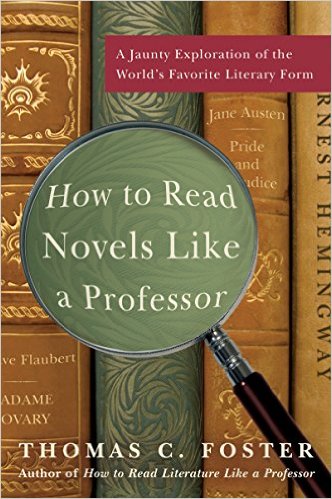
|
REVIEW
Another fun book from Foster talking about the Novel; why it is the way it is, and what parts go into making a good novel. For example: Modern novels are different from Victorian novels (think Dickens) because they are published as one part, where as Victorian novels were serialized in periodicals. This difference causes differences in the way they flow and how they are organized. He discusses chapters and what they mean, points of view, the 18 things a first page can and should do (and that is just the first page). If you ever read a novel, then you will probably enjoy this tongue in cheek book about novel. I highly recommend this book along with his other,How To Read Literature Like A Professor.
Of all the literary forms, the novel is arguably the most discussed . . . and fretted over. From Miguel de Cervantes's Don Quixote to the works of Jane Austen, F. Scott Fitzgerald, Ernest Hemingway, and today's masters, the novel has grown with and adapted to changing societies and technologies, mixing tradition and innovation in every age throughout history.
Thomas C. Foster—the sage and scholar who ingeniously led readers through the fascinating symbolic codes of great literature in his first book, How to Read Literature Like a Professor—now examines the grammar of the popular novel. Exploring how authors' choices about structure—point of view, narrative voice, first page, chapter construction, character emblems, and narrative (dis)continuity—create meaning and a special literary language, How to Read Novels Like a Professor shares the keys to this language with readers who want to get more insight, more understanding, and more pleasure from their reading.
SUMMARY
Of all the literary forms, the novel is arguably the most discussed . . . and fretted over. From Miguel de Cervantes's Don Quixote to the works of Jane Austen, F. Scott Fitzgerald, Ernest Hemingway, and today's masters, the novel has grown with and adapted to changing societies and technologies, mixing tradition and innovation in every age throughout history.
Thomas C. Foster—the sage and scholar who ingeniously led readers through the fascinating symbolic codes of great literature in his first book, How to Read Literature Like a Professor—now examines the grammar of the popular novel. Exploring how authors' choices about structure—point of view, narrative voice, first page, chapter construction, character emblems, and narrative (dis)continuity—create meaning and a special literary language, How to Read Novels Like a Professor shares the keys to this language with readers who want to get more insight, more understanding, and more pleasure from their reading
|
|
| 29 |
Gladwell, Malcolm
(2) |

|

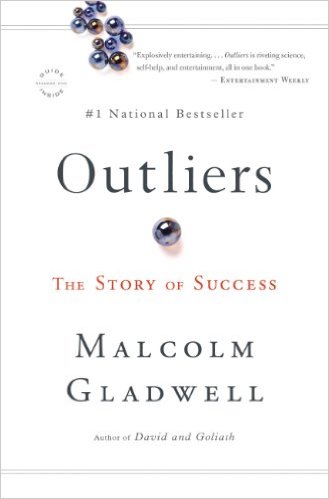
|
REVIEW
This is an interesting little book on what makes people successful - and sometimes it not what you think. In fact, sometimes it's just the right circumstances coming together in just the right way. Successful people are not necessarily better than you and I... most of them hit a set of circumstances and were in the right place at the right time. One example: There is a system in place in Canada to "grow" the best hockey players so that eventually, only the best are playing on the national teams. But the system has a bias built into it. A bias that means that 90% of all the top Canadian hockey players are born in Jan. Feb or March. If you are born in November, it doesn't matter how good you are... you're not going to make it to the top. Why? Read the book and find out. Another example: Korean airlines used to have the worst safety record of any airlines. The planes were maintained well. The crew was competent. So what made these plane crash so much more than any other airline on the planet. Turns out.. it was the Korean culture itself. Once someone recognized that new training was put into place, and now the airline is as good as any, and better than some that still suffer the same problem (don't fly on any airliner with a south American crew). What in the culture was doing this? Respect for authority. This book is, well, anecdotal. Not as good as The Tipping Point because it doesn't give you a blue print for success. But interesting to see how people who think they made it all on their own really got their boost from a set of circumstances that were completely outside their control. The moral: It pays to be in the right place at the right time.
In this stunning new book, Malcolm Gladwell takes us on an intellectual journey through the world of "outliers"--the best and the brightest, the most famous and the most successful. He asks the question: what makes high-achievers different?
His answer is that we pay too much attention to what successful people are like, and too little attention to where they are from: that is, their culture, their family, their generation, and the idiosyncratic experiences of their upbringing. Along the way he explains the secrets of software billionaires, what it takes to be a great soccer player, why Asians are good at math, and what made the Beatles the greatest rock band.
SUMMARY
There is a story that is usually told about extremely successful people, a story that focuses on intelligence and ambition. Gladwell argues that the true story of success is very different, and that if we want to understand how some people thrive, we should spend more time looking around them-at such things as their family, their birthplace, or even their birth date. And in revealing that hidden logic, Gladwell presents a fascinating and provocative blueprint for making the most of human potential.
|
|
| 30 |
Gladwell, Malcolm
(2) |

|

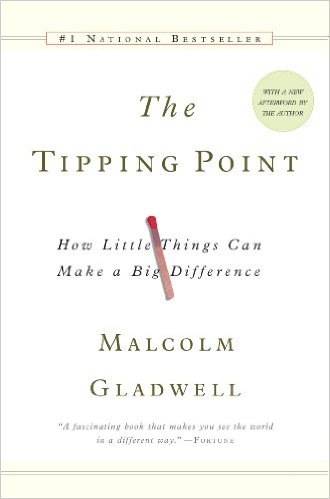
|
REVIEW
Excellent book on how change happens. Analyses all the factors that cause a small change to sweep the nation. Examples from the real world are analyzed (Hush Puppies Shoes, Sesame St., Paul Revere's Ride, Crime rates in New York, Blues Clues, etc) to show how the following factors affect whether an idea, product, or trend takes off, or languishes in the doldrums. Stickiness - Does the concept have something that makes it stick Mavens, Connectors, Salesman - Does it have people who can promote the idea in different ways. more to write here..
The tipping point is that magic moment when an idea, trend, or social behavior crosses a threshold, tips, and spreads like wildfire. Just as a single sick person can start an epidemic of the flu, so too can a small but precisely targeted push cause a fashion trend, the popularity of a new product, or a drop in the crime rate. This widely acclaimed bestseller, in which Malcolm Gladwell explores and brilliantly illuminates the tipping point phenomenon, is already changing the way people throughout the world think about selling products and disseminating ideas.
SUMMARY
The tipping point is that magic moment when an idea, trend, or social behavior crosses a threshold, tips, and spreads like wildfire. Just as a single sick person can start an epidemic of the flu, so too can a small but precisely targeted push cause a fashion trend, the popularity of a new product, or a drop in the crime rate. This widely acclaimed bestseller, in which Malcolm Gladwell explores and brilliantly illuminates the tipping point phenomenon, is already changing the way people throughout the world think about selling products and disseminating ideas.
|
|
| 31 |
Glover, Robert A.
(1) |
|
No More Mr. Nice Guy!(Instructional)

|

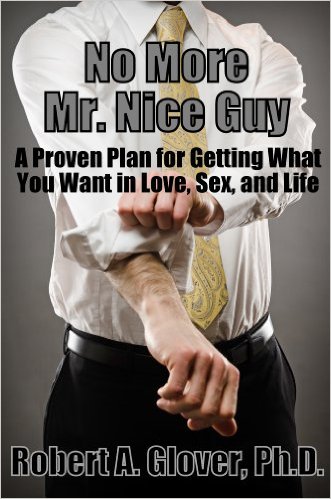
|
REVIEW
A pretty good book for men who have problems communicating their wants and needs; who rely on passive aggressive methods, and non-verbal deals that just never seem to work out. I'll confess to having problems getting my needs out there for other people to know, so this is probably a good book for guys like me.
SUMMARY
Originally published as an e-book that became a controversial media phenomenon, No More Mr. Nice Guy! landed its author, a certified marriage and family therapist, on The O'Reilly Factor and the Rush Limbaugh radio show. Dr. Robert Glover has dubbed the "Nice Guy Syndrome" trying too hard to please others while neglecting one's own needs, thus causing unhappiness and resentfulness. It's no wonder that unfulfilled Nice Guys lash out in frustration at their loved ones, claims Dr. Glover. He explains how they can stop seeking approval and start getting what they want in life, by presenting the information and tools to help them ensure their needs are met, to express their emotions, to have a satisfying sex life, to embrace their masculinity and form meaningful relationships with other men, and to live up to their creative potential.
|
|
| 32 |
Graff, Garrett M.
(1) |
|
Raven Rock: The Story of the U.S. Government's Secret Plan to Save Itself?While the Rest of Us Die(History)

|

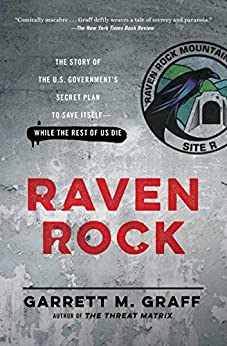
|
REVIEW
Everyone knows that the government has secret (and not so secret) plans to save themselves in the event of a nuclear war. But what do those plans entail? What parts of the goverment are considered important enough to save? What people are considered important enough? NOTE: Most of the people considered important enough won't go without their wives and families... and they are NOT included.
Over the years this became more and less important.. and more and less adequate. It all depended on what the particular administration thought at the time. It's no wonder that during nearly every test of the system... it failed. In interesting read.
SUMMARY
The shocking truth about the government?s secret plans to survive a catastrophic attack on US soil?even if the rest of us die?is ?a frightening eye-opener? (Kirkus Reviews) that spans the dawn of the nuclear age to today, and "contains everything one could possibly want to know" (The Wall Street Journal).
Every day in Washington, DC, the blue-and-gold first Helicopter Squadron, codenamed ?MUSSEL,? flies over the Potomac River. As obvious as the Presidential motorcade, most people assume the squadron is a travel perk for VIPs. They?re only half right: while the helicopters do provide transport, the unit exists to evacuate high-ranking officials in the event of a terrorist or nuclear attack on the capital. In the event of an attack, select officials would be whisked by helicopters to a ring of secret bunkers around Washington, even as ordinary citizens were left to fend for themselves.
?In exploring the incredible lengths (and depths) that successive administrations have gone to in planning for the aftermath of a nuclear assault, Graff deftly weaves a tale of secrecy and paranoia? (The New York Times Book Review) with details "that read like they've been ripped from the pages of a pulp spy novel" (Vice). For more than sixty years, the US government has been developing secret Doomsday strategies to protect itself, and the multibillion-dollar Continuity of Government (COG) program takes numerous forms?from its potential to evacuate the Liberty Bell from Philadelphia to the plans to launch nuclear missiles from a Boeing-747 jet flying high over Nebraska. Garrett M. Graff sheds light on the inner workings of the 650-acre compound, called Raven Rock, just miles from Camp David, as well as dozens of other bunkers the government built for its top leaders during the Cold War, from the White House lawn to Cheyenne Mountain in Colorado to Palm Beach, Florida, and the secret plans that would have kicked in after a Cold War nuclear attack to round up foreigners and dissidents and nationalize industries. Equal parts a presidential, military, and cultural history, Raven Rock tracks the evolution of the government plan and the threats of global war from the dawn of the nuclear era through the War on Terror.
|
|
| 33 |
Grant, Linda
(1) |
|
Sexing the Millennium: A Political History of the Sexual Revolution(Politics)

|

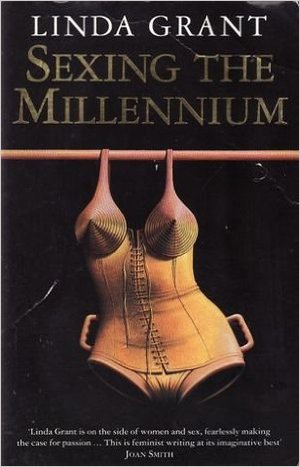
|
REVIEW
An interesting book about the sexual revolution from a woman's point of view. A review of history, and a look ahead to the future. Many people seem to think that things have not improved for women sexually in the last century. Nothing could be further from the truth - in fact - the changes have been revolutionary, and Linda Grant explores them in this slim little volume.
SUMMARY
|
|
| 34 |
Gray, Michael
(1) |
|
Drug Crazy: How We Got Into This Mess and How We Can Get Out(Politics)

|


|
REVIEW
The title says it all. How did we get into this mess with drugs. How can we get out. Once upon a time heroin was le gal and available, and the addicts were tax paying citizens. Then we made it illegal – increasing crime – increasing disease – increasing suffering – and for WHAT? When it was legal 90% of the addicts would kick on their own once they were no longer getting the high they wanted. This is the new prohibition and it’s just as stupid as the old prohibition – which gave us organized crime that lasts until today. Read this and get a wake up call.
SUMMARY
None available
|
|
| 35 |
Greene, Brian
(1) |


|

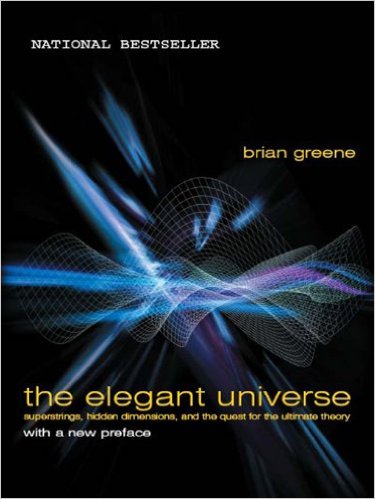
|
REVIEW
String theory is hard to understand. This book makes it understandable. I didn't make it to the end as the sections on how folded space can be equal to a differently folded space, but the first 2/3rds of the book are magnificent. The absolute best explanations for Special and General Relativity ANYWHERE. The best explanations for how the universe can have more than the 4 dimensions we can see and feel. A completely clear explanation of how fast we are all traveling through the dimension of TIME (we are traveling at the speed of light through the dimension of time.. simple once he explains it). This, with The Whole Shebang is all the physics you should need if you want to know where we all came from.
Brian Greene, one of the world's leading string theorists, peels away layers of mystery to reveal a universe that consists of eleven dimensions, where the fabric of space tears and repairs itself, and all matter?from the smallest quarks to the most gargantuan supernovas?is generated by the vibrations of microscopically tiny loops of energy. The Elegant Universe makes some of the most sophisticated concepts ever contemplated accessible and thoroughly entertaining, bringing us closer than ever to understanding how the universe works.
SUMMARY
Today physicists and mathematicians throughout the world are feverishly working on one of the most ambitious theories ever proposed: superstring theory. String theory, as it is often called, is the key to the Unified Field Theory that eluded Einstein for more than thirty years. Finally, the century-old antagonism between the large and the small-General Relativity and Quantum Theory-is resolved. String theory proclaims that all of the wondrous happenings in the universe, from the frantic dancing of subatomic quarks to the majestic swirling of heavenly galaxies, are reflections of one grand physical principle and manifestations of one single entity: microscopically tiny vibrating loops of energy, a billionth of a billionth the size of an atom. In this brilliantly articulated and refreshingly clear book, Greene relates the scientific story and the human struggle behind twentieth-century physics' search for a theory of everything.
Through the masterful use of metaphor and analogy, The Elegant Universe makes some of the most sophisticated concepts ever contemplated viscerally accessible and thoroughly entertaining, bringing us closer than ever to understanding how the universe works.
|
|
| 36 |
Harris, Judith Rich
(1) |

|

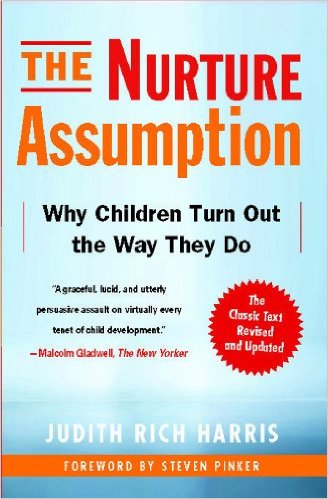
|
REVIEW
Judith Harris was a child psychologist to towed the line about nurture being the primary force that controls how children turn out in life. But then she began to study the research and found that this was not the whole story. Any one of you who have seen how boys pop out being boys right away, and girls pop out being girls, will realize that something BIG is going on in the background that has nothing to do with nurture. This is another book I picked up on my quest to understand evolution and evolutionary psychology. I’d recommend it to ANYONE who is interested in how kids grow, develop, and become the people they will be.
SUMMARY
This groundbreaking book, a Pulitzer Prize finalist and New York Times notable pick, rattled the psychological establishment when it was first published in 1998 by claiming that parents have little impact on their children's development. In this tenth anniversary edition of The Nurture Assumption, Judith Harris has updated material throughout and provided a fresh introduction.
Combining insights from psychology, sociology, anthropology, primatology, and evolutionary biology, she explains how and why the tendency of children to take cues from their peers works to their evolutionary advantage. This electrifying book explodes many of our unquestioned beliefs about children and parents and gives us a radically new view of childhood.
|
|
| 37 |
Harris, Sam
(2) |


|

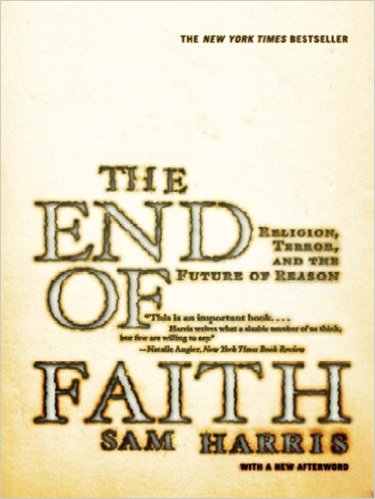
|
REVIEW
It took a while, and I was coming to it on my own, but this is the book that completely turned my opinion of organized religion 180 degrees from benign tolerance to believing that religion is the problem, not the solution. In parts this books gets pretty heavily philosophical, but for the most it slams it’s point home, again and again – with examples we all can relate to. It makes the argument that religious belief should be defined as insanity because we treat it like any other belief (i.e. things we can test) and as a result we run governments, have wars, and commit genocide – because of religion. Think of it this way: No person could ever be elected U.S. President without professing a belief in an invisible being who watches over us. A being we do not know; who cannot be shown to exist; and for which no evidence exists. Yet, all candidates must admit to this insanity in order to control the largest nuclear arsenal on the planet. If that does not scare you, nothing will Extremely Recommended.
SUMMARY
"The End of Faith articulates the dangers and absurdities of organized religion so fiercely and so fearlessly that I felt relieved as I read it, vindicated....Harris writes what a sizable number of us think, but few are willing to say."?Natalie Angier, ?New York Times
In ?The End of Faith?, Sam Harris delivers a startling analysis of the clash between reason and religion in the modern world. He offers a vivid, historical tour of our willingness to suspend reason in favor of religious beliefs?even when these beliefs inspire the worst human atrocities. While warning against the encroachment of organized religion into world politics, Harris draws on insights from neuroscience, philosophy, and Eastern mysticism to deliver a call for a truly modern foundation for ethics and spirituality that is both secular and humanistic. Winner of the 2005 PEN/Martha Albrand Award for Nonfiction.
|
|
| 38 |
Harris, Sam
(2) |


|

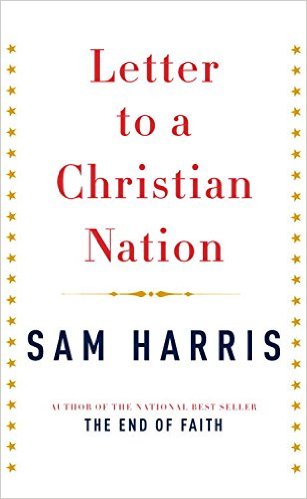
|
REVIEW
Sam Harris wrote The End Of Faith - in which he pointed out how religion makes no sense, and does actual harm. Much of that book was spent on Islam, but Christianity took it's lumps too. Well, apparently he got lots of (hate) mail defending Christianity, so he decided to write a short book that focuses on the arguments in the letters like a laser beam. The book is short, concise and to the point. One can read it in less than a day. I takes all the reasonable sounding arguments in defense of Christianity... and shows them to absurd, and in fact, harmful. (Ex. Missionary who teach that condoms are bad or a sin in Sub-Saharan Africa where millions are dying of AIDS every year. These people are committing genocide because their GOD cares whether they wear a sheath of rubber on their penis. God save us.) If you are a Christian, then nothing anyone can say will shake your belief - so no harm can come from reading this. If you have your doubts, then this can provide clarity And if you worship Zeus then you can use the arguments in here to prove that YOU are right and everyone else is wrong... And if you are a fan of the flying Spaghetti monster then you probably already know everything in here.. but it doesn't hurt to read it anyway. I give this a big thumbs up.
SUMMARY
From the new afterword by the author:Humanity has had a long fascination with blood sacrifice. In fact, it has been by no means uncommon for a child to be born into this world only to be patiently and lovingly reared by religious maniacs, who believe that the best way to keep the sun on its course or to ensure a rich harvest is to lead him by tender hand into a field or to a mountaintop and bury, butcher, or burn him alive as offering to an invisible God. The notion that Jesus Christ died for our sins and that his death constitutes a successful propitiation of a "loving" God is a direct and undisguised inheritance of the superstitious bloodletting that has plagued bewildered people throughout history. . .
|
|
| 39 |
Heil, Nick
(1) |
|
Dark Summit: The True Story of Everest's Most Controversial Season(History)
UNRATED
|

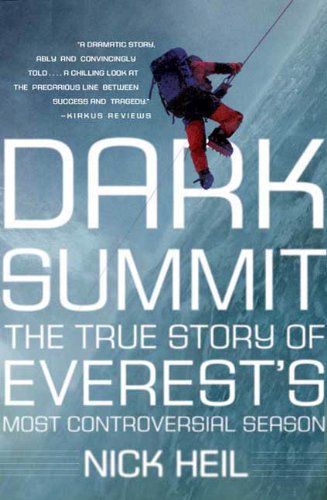
|
REVIEW
I don't know why stories of Everest fascinate me so. I guess it is because I am curious what it would be like to test myself in a deadly environment where one wrong judgment can lead to your death and the deaths of others. In the extreme environment of the death zone on Everest, things that seem so simple can be tragically wrong. And the ONLY person you can truly rely on is yourself - because no one else has the energy to save you if you screw up. It is just fascinating.
SUMMARY
The inside story of the deadly 2006 climbing season on Everest
On May 15, 2006, a young British climber named David Sharp lay dying near the top of Mount Everest while forty other climbers walked past him on their way to the summit. A week later, Lincoln Hall, a seasoned Australian climber, was left for dead near the same spot. Hall's death was reported around the world, but the next day he was found alive after spending the night on the upper mountain with no food and no shelter.
If David Sharp's death was shocking, it was hardly singular: despite unusually good weather, ten others died attempting to reach the summit that year. In this meticulous inquiry into what went wrong, Nick Heil tells the full story of the deadliest year on Everest since the infamous season of 1996. He introduces Russell Brice, the commercial operator who has done more than anyone to provide access to the summit via the mountain's north side?and who some believe was partly accountable for Sharp's death. As more climbers attempt the summit each year, Heil shows how increasingly risky expeditions and unscrupulous outfitters threaten to turn Everest into a deadly circus.
Written by an experienced climber and outdoor writer, Dark Summit is both a riveting account of a notorious climbing season and a troubling investigation into whether the pursuit of the ultimate mountaineering prize has spiraled out of control.
|
|
| 40 |
Hickam, Homer
(1) |


 |

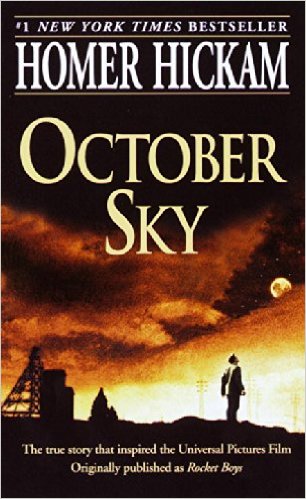
|
REVIEW
I saw this movie ages ago, and years later decided to read the book. The book is marvelous at giving you a sense of what it was to grow up in a mining community, but have your heart on the stars.
SUMMARY
It was 1957, the year Sputnik raced across the Appalachian sky, and the small town of Coalwood, West Virginia, was slowly dying.
Faced with an uncertain future, Homer Hickam nurtured a dream: to send rockets into outer space. The introspective son of the mine's superintendent and a mother determined to get him out of Coalwood forever, Homer fell in with a group of misfits who learned not only how to turn scraps of metal into sophisticated rockets but how to sustain their hope in a town that swallowed its men alive.
As the boys began to light up the tarry skies with their flaming projectiles and dreams of glory, Coalwood, and the Hickams, would never be the same.
|
|
| 41 |
Hitchens, Christoper
(1) |

|

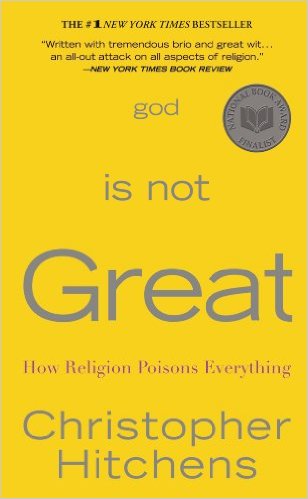
|
REVIEW
Dude, you are preaching to the choir. Another in the recent spate of books discussing god and religion objectively - and why both are poisons our civilizations need to stop drinking. It's obvious that Mr. Hitchens has explored deeply into the religious life (attending several different religious institutions before deciding they were all dreck.) All the standard arguments are fully covered some more readable than others (get out your philosophy waders at points). I recommend this book to anyone who, like me, thinks religion is for the birds, and that continued indulgence of this sort of "belief" is going to become toxic in the future.
SUMMARY
In the tradition of Bertrand Russell's Why I Am Not a Christian and Sam Harris's recent bestseller, The End of Faith, Christopher Hitchens makes the ultimate case against religion. With a close and erudite reading of the major religious texts, he documents the ways in which religion is a man-made wish, a cause of dangerous sexual repression, and a distortion of our origins in the cosmos. With eloquent clarity, Hitchens frames the argument for a more secular life based on science and reason, in which hell is replaced by the Hubble Telescope's awesome view of the universe, and Moses and the burning bush give way to the beauty and symmetry
of the double helix.
|
|
| 42 |
Hochschild, Adam
(1) |
|
To End All Wars: A Story of Loyalty and Rebellion, 1914-1918(History)


|

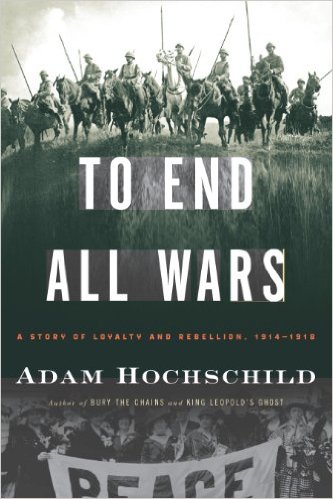
|
REVIEW
I never read any history of World War I prior to this book. This book makes it clear that the entire war was a colossal waste of life. The people giving the orders had no clue what they were doing. They had no care for the soldiers whose lives they carelessly threw away - for years. If ever there was a war crime, these people committed them.
And little know, and never discussed, are the people who opposed the war. They were labeled traitors and yet they were right. Right to oppose this horrible waste of human life.
If you read no other history of WWI, read this one.
SUMMARY
World War I was supposed to be the "war to end all wars." Over four long years, nations around the globe were sucked into the tempest, and millions of men died on the battlefields. To this day, the war stands as one of history's most senseless spasms of carnage, defying rational explanation.
To End All Wars focuses on the long-ignored moral drama of the war's critics, alongside its generals and heroes. Many of these dissenters were thrown in jail for their opposition to the war, from a future Nobel Prize winner to an editor behind bars who distributed a clandestine newspaper on toilet paper. These critics were sometimes intimately connected to their enemy hawks: one of Britain's most prominent women pacifist campaigners had a brother who was commander in chief on the Western Front. Two well-known sisters split so bitterly over the war that they ended up publishing newspapers that attacked each other.
As Adam Hochschild brings the Great War to life as never before, he forces us to confront the big questions: Why did so many nations get so swept up in the violence? Why couldn't cooler heads prevail? And can we ever avoid repeating history?
|
|
| 43 |
Huxley, Aldous
(4) |


|

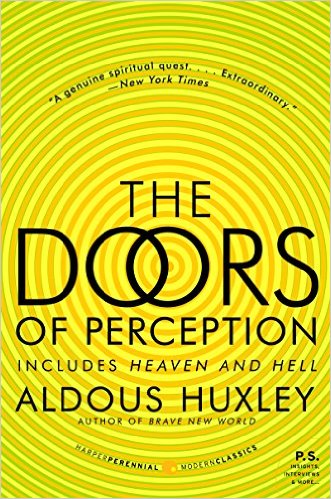
|
REVIEW
I was in college when I read this book for the first time... It opened doors for me that I had never thought of... amazing doors that allowed me to go places my scientific western orientation had never let me go before. Basically it's like this...>What if your brain... the organ of your perception... was really a FILTER, designed to eliminate input that was not important for the survival of the entity it was controlling?
Of course, your thinking ... it has to filter out things otherwise we would be bombarded with sensory input. You can't constantly be feeling your left foot (in fact, I know you weren't feeling it until you read this)... it would all be too distracting The question then becomes.... exactly what is it filtering OUT? It's like complaining to the post office about not getting your mail and having them say... "Well, what mail are you not getting?"
You have no way of knowing...
Ever learn a new word... and suddenly you see that word in lots of place in print? Was it being filtered out before?
Ever drive a rental car that you never drove before, and all of a sudden you see them everywhere on the road? Were they being filtered out before?
Ever hear someone talk about experiencing GOD directly and think they must be completely nuts? Is your filter in place?
Talking to GOD does not put food on the table... In fact, it has a tendency to have the opposite effect. Perhaps the ability to perceive GOD directly was evolved OUT because it didn't ensure the survival of the species.
In any case, this little book (actually 2 short essays) will make you wonder about what your own brain is filtering out... and about some of those experiences that everyone has that cause that filter to break down... how you can have a non-filtered experience, if you care to pursue that.. and to wonder about what you really do experience when you go beyond your normal perceptions..
SUMMARY
In 1952 Aldous Huxley became involved in the now legendary experiment to clinically detail the physiological and psycho-logical effects of the little known drug used by Mexican and Native American elders in religious practices. The drug was Peyote-now commonly know as mescalin. By the standards of the time, Huxley was a hard working, respected, and reserved intellectual from a highly intelligent, well-know, and eccentric British family. By any standards, the results of the experiment were remarkable. The Doors of Perception and Heaven and Hell detail the practic-alities of the experiment and give Huxley's vivid account of his im-mediate experience and the more prolonged effect upon his sub-sequent thinking and awareness. At first, the reader is drawn in by the sheer naivety and tom-foolery of the proposal but is soon caught in a finely woven net by the juxtaposition of Huxley's formidable intellect, his remarkable ability to convey the experience in such acute and truthful detail, and his incredible modesty. In 1922 Gertrude Stein famously wrote - A rose is a rose is a rose. In proving her right, Huxley also shows the deeper meaning be-hind the apparently simple verse and goes on to deliver such spec-tacular accounts of the most everyday objects that the reason for their repeated and continual renderings by all the major artists throughout history suddenly becomes quite clear. For the con-scious and willing reader - a trip to the Guggenheim, the Louvre or the Tate Modern will never be the same again.
|
|
| 44 |
Jacobs, Arnold Stephen - A.J.
(1) |

|

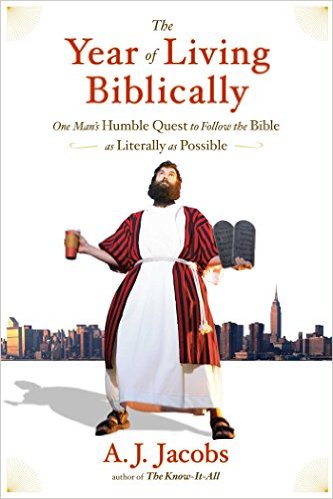
|
REVIEW
This book was strange and interesting. You learn things about the bible and the rules in it that you would never have heard from anyone else. (eg. Why are 100's of people devoting themselves to breeding a perfectly red calf - why, to bring about the end times, of course!!) At times odd; at times revelatory; at times funny (his wife does not participate - but frequently takes advantage of his requirement to follow "the rules") this book will teach you many things I promise you had no clue existed in the Bible
Read this only if you have an open mind when it comes to different religious experiences... It's funny and interesting.
SUMMARY
Raised in a secular family but increasingly interested in the relevance of faith in our modern world, A.J. Jacobs decides to dive in headfirst and attempt to obey the Bible as literally as possible for one full year. He vows to follow the Ten Commandments. To be fruitful and multiply. To love his neighbor. But also to obey the hundreds of less publicized rules: to avoid wearing clothes made of mixed fibers; to play a ten-string harp; to stone adulterers.
The resulting spiritual journey is at once funny and profound, reverent and irreverent, personal and universal and will make you see history's most influential book with new eyes.
Jacobs's quest transforms his life even more radically than the year spent reading the entire Encyclopedia Britannica for The Know-It-All. His beard grows so unruly that he is regularly mistaken for a member of ZZ Top. He immerses himself in prayer, tends sheep in the Israeli desert, battles idolatry, and tells the absolute truth in all situations—much to his wife's chagrin.
Throughout the book, Jacobs also embeds himself in a cross-section of communities that take the Bible literally. He tours a Kentucky-based creationist museum and sings hymns with Pennsylvania Amish. He dances with Hasidic Jews in Brooklyn and does Scripture study with Jehovah's Witnesses. He discovers ancient biblical wisdom of startling relevance. And he wrestles with seemingly archaic rules that baffle the twenty-first-century brain.
Jacobs's extraordinary undertaking yields unexpected epiphanies and challenges. A book that will charm readers both secular and religious, The Year of Living Biblically is part Cliff Notes to the Bible, part memoir, and part look into worlds unimaginable. Thou shalt not be able to put it down.
|
|
| 45 |
Kennedy, Randall
(1) |



|

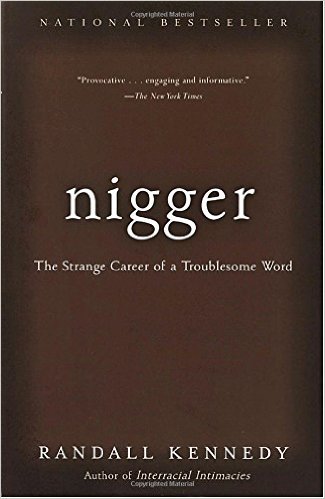
|
REVIEW
This is a great book to read before diving into the controversy about the word nigger and the usage of it in modern America. This book explores every aspect and reaction to the word. He explores how it has been used in legal issues (the fighting words rules), and how that has evolved over time - also, what it would mean if one interpretation became prevalent over another. He looks at the usage in various cultural aspects - literature, music, film, and how people have reacted. He talks about how people want to deal with the word from those who are willing to tolerate all uses to those who would ban every use without regard to meaning (ex. Huck Finn is an anti-racism novel - but people think it is racist because of the use of nigger constantly.) He discusses racial privilege where in one race is allowed the use of a word that other races are not.
Basically, if you are going to have an opinion on this matter, you should read this book to be fully informed of ALL the issues from ALL sides. Nothing is left unexamined. This book is a great service to race relations and deserves to be read by anyone who wants to be informed in this matter.
SUMMARY
It?s ?the nuclear bomb of racial epithets,? a word that whites have employed to wound and degrade African Americans for three centuries. Paradoxically, among many black people it has become a term of affection and even empowerment. The word, of course, is nigger, and in this candid, lucidly argued book the distinguished legal scholar Randall Kennedy traces its origins, maps its multifarious connotations, and explores the controversies that rage around it.
Should blacks be able to use nigger in ways forbidden to others? Should the law treat it as a provocation that reduces the culpability of those who respond to it violently? Should it cost a person his job, or a book like Huckleberry Finn its place on library shelves? With a range of reference that extends from the Jim Crow south to Chris Rock routines and the O. J. Simpson trial, Kennedy takes on not just a word, but our laws, attitudes, and culture with bracing courage and intelligence.
|
|
| 46 |
Kipling, Rudyard
(3) |

|

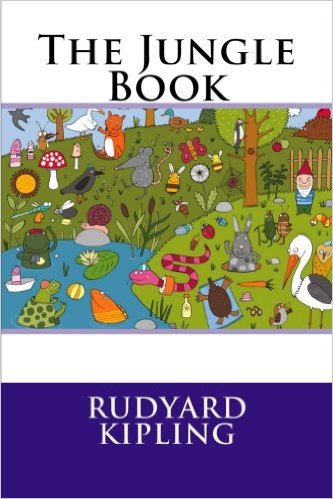
|
REVIEW
Absolutely NOTHING like anything Disney would have you think, this book of stories is interesting given Kipling's intimate knowledge of India and the culture (from his British perspective of course).
An interesting read, but not something I would recommend. Better to read his book KIM.
SUMMARY
The Jungle Book (1894) is a collection of stories by English author Rudyard Kipling. The stories were first published in magazines in 1893–94. The original publications contain illustrations, some by Rudyard's father, John Lockwood Kipling. Kipling was born in India and spent the first six years of his childhood there. After about ten years in England, he went back to India and worked there for about six-and-a-half years. These stories were written when Kipling lived in Vermont. There is evidence that it was written for his daughter Josephine, who died in 1899 aged six, after a rare first edition of the book with a poignant handwritten note by the author to his young daughter was discovered at the National Trust's Wimpole Hall in Cambridgeshire in 2010. The tales in the book (and also those in The Second Jungle Book which followed in 1895, and which includes five further stories about Mowgli) are fables, using animals in an anthropomorphic manner to give moral lessons. The verses of The Law of the Jungle, for example, lay down rules for the safety of individuals, families and communities. Kipling put in them nearly everything he knew or "heard or dreamed about the Indian jungle." Other readers have interpreted the work as allegories of the politics and society of the time. The best-known of them are the three stories revolving around the adventures of an abandoned "man cub" Mowgli who is raised by wolves in the Indian jungle. The most famous of the other stories are probably "Rikki-Tikki-Tavi", the story of a heroic mongoose, and "Toomai of the Elephants", the tale of a young elephant-handler. As with much of Kipling's work, each of the stories is preceded by a piece of verse, and succeeded by another.
|
|
| 47 |
Koeppel, Dan
(1) |

|


|
REVIEW
The lowly banana. Our grand-parents ate a kind of banana called the Gros Micheal. It was sweeter, and easier to ship because of a tougher skin than the banana's we eat today. And now it's extinct. Today we eat the Cavendish banana. And it's going extinct. Better enjoy your bananas while you can. Because in the future, the only bananas available will be genetically manipulated. Ever find a seed in a banana? Every banana is a clone of every other banana... which is why when something hits.. that kind of banana gets wiped out. The only answer to save them is genetic manipulation. An interesting book with more about how banana companies (with the help of the U.S. Government) over-threw any south American government they didn't like all so we could keep eating cheap fruit.
In this fascinating and surprising exploration of the banana’s history, cultural significance, and endangered future, award-winning journalist Dan Koeppel gives readers plenty of food for thought. Fast-paced and highly entertaining, Banana takes us from jungle to supermarket, from corporate boardrooms to kitchen tables around the world. We begin in the Garden of Eden—examining scholars’ belief that Eve’s “apple” was actually a banana— and travel to early-twentieth-century Central America, where aptly named “banana republics” rose and fell over the crop, while the companies now known as Chiquita and Dole conquered the marketplace. Koeppel then chronicles the banana’s path to the present, ultimately—and most alarmingly—taking us to banana plantations across the globe that are being destroyed by a fast-moving blight, with no cure in sight—and to the high-tech labs where new bananas are literally being built in test tubes, in a race to save the world’s most beloved fruit.
SUMMARY
A gripping biological detective story that uncovers the myth, mystery, and endangered fate of the world's most humble fruit
To most people, a banana is a banana: a simple yellow fruit. Americans eat more bananas than apples and oranges combined. In others parts of the world, bananas are what keep millions of people alive. But for all its ubiquity, the banana is surprisingly mysterious; nobody knows how bananas evolved or exactly where they originated. Rich cultural lore surrounds the fruit: In ancient translations of the Bible, the "apple" consumed by Eve is actually a banana (it makes sense, doesn't it?). Entire Central American nations have been said to rise and fall over the banana.
But the biggest mystery about the banana today is whether it will survive. A seedless fruit with a unique reproductive system, every banana is a genetic duplicate of the next, and therefore susceptible to the same blights. Today's yellow banana, the Cavendish, is increasingly threatened by such a blight—and there's no cure in sight.
Banana combines a pop-science journey around the globe, a fascinating tale of an iconic American business enterprise, and a look into the alternately tragic and hilarious banana subculture (one does exist)—ultimately taking us to the high-tech labs where new bananas are literally being built in test tubes, in a race to save the world's most beloved fruit.
|
|
| 48 |
Kolata, Gina
(1) |
|
Flu: The Story Of The Great Influenza Pandemic(Science - General)

|

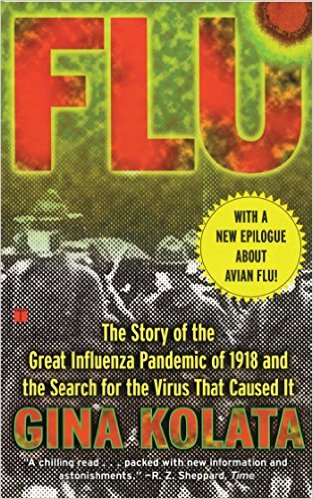
|
REVIEW
Another truly scary book about the great flu pandemic of the early 20th century. And a detailed discussion of the search for preserved bodies from that time that may contain the virus still. You get to go on an expedition to the permafrost where old records show several people were buried whose bodies my yet contain the preserved virus due to the cold. ookie !!!
The fascinating, true story of the world's deadliest disease. In 1918, the Great Flu Epidemic felled the young and healthy virtually overnight. An estimated forty million people died as the epidemic raged. Children were left orphaned and families were devastated. As many American soldiers were killed by the 1918 flu as were killed in battle during World War I. And no area of the globe was safe. Eskimos living in remote outposts in the frozen tundra were sickened and killed by the flu in such numbers that entire villages were wiped out. Scientists have recently rediscovered shards of the flu virus frozen in Alaska and preserved in scraps of tissue in a government warehouse. Gina Kolata, an acclaimed reporter for The New York Times, unravels the mystery of this lethal virus with the high drama of a great adventure story. Delving into the history of the flu and previous epidemics, detailing the science and the latest understanding of this mortal disease, Kolata addresses the prospects for a great epidemic recurring, and, most important, what can be done to prevent it.
SUMMARY
A national bestseller, the fast-paced and gripping account of the Great Flu Epidemic of 1918 from acclaimed science journalist Gina Kolata, now featuring a new epilogue about avian flu.
When we think of plagues, we think of AIDS, Ebola, anthrax spores, and, of course, the Black Death. But in 1918 the Great Flu Epidemic killed an estimated forty million people virtually overnight. If such a plague returned today, taking a comparable percentage of the US population with it, 1.5 million Americans would die.
In Flu, Gina Kolata, an acclaimed reporter for The New York Times, unravels the mystery of this lethal virus with the high drama of a great adventure story. From Alaska to Norway, from the streets of Hong Kong to the corridors of the White House, Kolata tracks the race to recover the live pathogen and probes the fear that has impelled government policy.
A gripping work of science writing, Flu addresses the prospects for a great epidemic's recurrence and considers what can be done to prevent it.
|
|
| 49 |
Krakauer, Jon
(1) |


 |

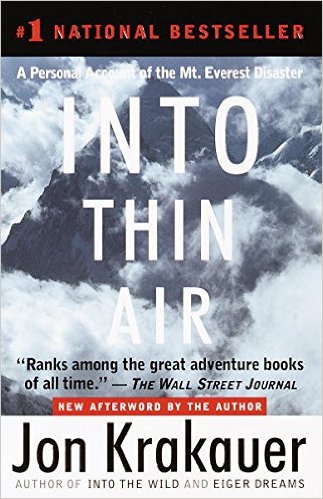
|
REVIEW
This is a blow by blow description of what happened on the mountain the day of the worst climbing disaster ever on Mount Everest. A little dry in parts, still you will find your heart pounding and wonder why all those people had to die when half of them could have saved themselves!!
SUMMARY
This is Jon Krakauers book about the 1996 Expedition to the top of Mt. Everest that caused so many deaths. It is excellently written and extremely detailed. The tragic events of that one day where 12 people died on the mountain (and are mostly still there) are laid out in a readable and compelling manner. There is some controversy regarding the events as described by Krakauer and by Anatoli Boukreev in his book THE CLIMB. People have said that as a guide, Boukreev did not act properly, in climbing without gas, and in leaving clients to descend on their own. Read both books and decide for yourself.
In any case, this is a great book and was mostly the basis of the 2015 Movie - Everest. A great film.
|
|
| 50 |
Kurlansky, Mark
(3) |
|
Milk!: A 10,000-Year Food Fracas(History)

|


|
REVIEW
Who knew that being lactose intolerant is the "normal" human condition, but that we have adapted over time so we can drink milk. And milk has quite a history.. What is the best milk and why? Is milk good for babies? How was cheese discovered and how many different kinds are there? What is the difference between raw and processed milk and what are the benefits of each? What cow gives the best milk? What is required to call milk organic? So many questions...
This book has many milk bases recipes that I glossed over (like his other books, SALT and COD) but each comes from a historical source as people over time experimented with cooking with milk (even using milk in cocktails). Unless you are really interested in this kind of history I would not recommend this - or unless you happen to like experimenting with milk recipes or cheese making. I happen to enjoy these kinds of single topic historical expositions.
SUMMARY
According to the Greek creation myth, we are so much spilt milk; a splatter of the goddess Hera's breast milk became our galaxy, the Milky Way. But while mother's milk may be the essence of nourishment, it is the milk of other mammals that humans have cultivated ever since the domestication of animals more than 10,000 years ago, originally as a source of cheese, yogurt, kefir, and all manner of edible innovations that rendered lactose digestible, and then, when genetic mutation made some of us lactose-tolerant, milk itself.
Before the industrial revolution, it was common for families to keep dairy cows and produce their own milk. But during the nineteenth century mass production and urbanization made milk safety a leading issue of the day, with milk-borne illnesses a common cause of death. Pasteurization slowly became a legislative matter. And today milk is a test case in the most pressing issues in food politics, from industrial farming and animal rights to GMOs, the locavore movement, and advocates for raw milk, who controversially reject pasteurization.
Profoundly intertwined with human civilization, milk has a compelling and a surprisingly global story to tell, and historian Mark Kurlansky is the perfect person to tell it. Tracing the liquid's diverse history from antiquity to the present, he details its curious and crucial role in cultural evolution, religion, nutrition, politics, and economics.
|
|
| 51 |
Kurlansky, Mark
(3) |
|
SALT: A World History(History)

|


|
REVIEW
Salt. The only rock we eat. How much history can it have. Amusingly enough... plenty. Lots of fun little facts in this book (like that any English town that ends in ..."wich" once had a salt works - or that the word SALARY and SOLDIER come from the word salt which was used as form of payment). How salt helped contribute to the American Revolution. How salt taxes were collected by monarchies - and how people got out of paying them. How important it was in preserving food - with recipes going back to roman times. This is a fun little read - perfect for a vacation or beach trip.
SUMMARY
In his fifth work of nonfiction, Mark Kurlansky turns his attention to a common household item with a long and intriguing history: salt. The only rock we eat, salt has shaped civilization from the very beginning, and its story is a glittering, often surprising part of the history of humankind. A substance so valuable it served as currency, salt has influenced the establishment of trade routes and cities, provoked and financed wars, secured empires, and inspired revolutions. Populated by colorful characters and filled with an unending series of fascinating details, Salt by Mark Kurlansky is a supremely entertaining, multi-layered masterpiece.
|
|
| 52 |
Lane, Nick
(1) |
|
Oxygen: The Molecule that Made the World(Science - General)

|

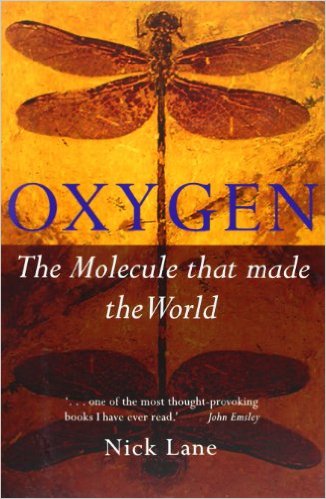
|
REVIEW
I'm not a chemist, but this book managed to explain things to me in a way that made them readily comprehensible. First, the amazing chain of events that allowed oxygen to form in our atmosphere and the influence of early chemistry and life on how to got to be where we are now. If people think that the chances of evolution are preposterous, they should read this book and realize how entirely incredible it is that we have the atmosphere we have today. Later in the book the process of respiration is explained - and if this doesn't scare your socks off, something is wrong with you. Free radicals are explained as juggernauts of destruction, and every breath you take imbues your system with a ton of the these monstrous little destroyers. Turns out the worst thing for your health is breathing !!! How evolution found was to stop these guys is an interesting part of this book. Complicate, but a good read, I recommend this to anyone with a scientific bent.
SUMMARY
In Oxygen, Nick Lane takes the reader on an enthralling journey as he unravels the unexpected ways in which oxygen spurred the evolution of life and death. He shows how oxygen underpins the origin of biological complexity, the birth of photosynthesis, the sudden evolution of animals, the need for two sexes, the accelerated aging of cloned animals like Dolly the sheep, and the surprisingly long lives of bats and birds. Drawing on this grand evolutionary canvas, Oxygen offers fresh perspectives on our own lives and deaths, explaining modern killer diseases, why we age, and what we can do about it. Advancing revelatory new ideas, following chains of evidence, the book ranges through many disciplines, from environmental sciences to molecular medicine. The result is a captivating vision of contemporary science and a humane synthesis of our place in nature. This remarkable book will redefine the way we think about the world.
|
|
| 53 |
Larson, Erik
(2) |



|

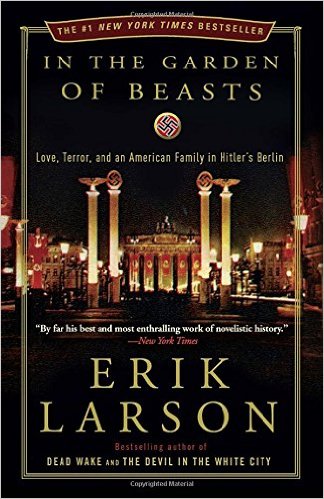
|
REVIEW
What was it like to live in Berlin while Hitler rose to power. What was it like to be the American Ambassador, trying to communicate the situation to your superiors in Washington, and having no one believe you. What was it like to have your family there, and know, the danger is all around, and could be coming for you any minute. This is a true story, and well worth the read.
SUMMARY
The time is 1933, the place, Berlin, when William E. Dodd becomes America's first ambassador to Hitler's Nazi Germany in a year that proved to be a turning point in history.
A mild-mannered professor from Chicago, Dodd brings along his wife, son, and flamboyant daughter, Martha. At first Martha is entranced by the parties and pomp, and the handsome young men of the Third Reich with their infectious enthusiasm for restoring Germany to a position of world prominence. Enamored of the "New Germany," she has one affair after another, including with the surprisingly honorable first chief of the Gestapo, Rudolf Diels. But as evidence of Jewish persecution mounts, confirmed by chilling first-person testimony, her father telegraphs his concerns to a largely indifferent State Department back home. Dodd watches with alarm as Jews are attacked, the press is censored, and drafts of frightening new laws begin to circulate. As that first year unfolds and the shadows deepen, the Dodds experience days full of excitement, intrigue, romance—and ultimately, horror, when a climactic spasm of violence and murder reveals Hitler's true character and ruthless ambition.
Suffused with the tense atmosphere of the period, and with unforgettable portraits of the bizarre Göring and the unexpectedly charming--yet wholly sinister--Goebbels, In the Garden of Beasts lends a stunning, eyewitness perspective on events as they unfold in real time, revealing an era of surprising nuance and complexity. The result is a dazzling, addictively readable work that speaks volumes about why the world did not recognize the grave threat posed by Hitler until Berlin, and Europe, were awash in blood and terror.
|
|
| 54 |
Larson, Erik
(2) |


|

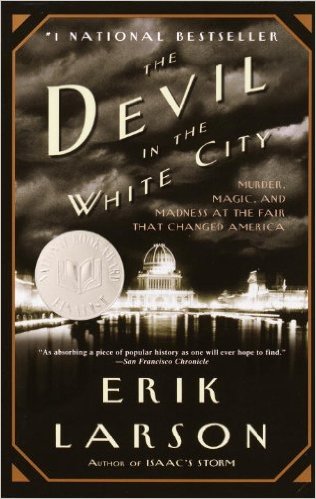
|
REVIEW
An absorbing piece of popular history as one will ever hope to find. Winner of the Edgar Award for Best Fact Crime. Another successful exploration of American history..Larson skillfully balances the grisly details with the far-reaching implications of the World's Fair.
intertwines the true tale of the 1893 World's Fair and the cunning serial killer who used the fair to lure his victims to their death. Combining meticulous research with nail-biting storytelling, Erik Larson has crafted a narrative with all the wonder of newly discovered history and the thrills of the best fiction.
The World's Fair in Chicago was being built. It was to be the largest exposition of its kind, involving many famous American and new technology that would shine for the whole world. It brought many people to Chicago - among them, a serial killer who ran a hotel to select his victims. Most disappeared without a trace. The true story of how a mass murderer got away with horror while all around him the city shined. This book was really excellent.
SUMMARY
An absorbing piece of popular history as one will ever hope to find. Winner of the Edgar Award for Best Fact Crime. Another successful exploration of American history..Larson skillfully balances the grisly details with the far-reaching implications of the World's Fair.
|
|
| 55 |
Lewis, Bernard
(1) |

|

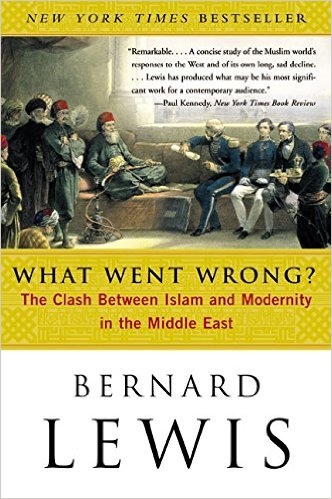
|
REVIEW
A history of Islamic identity, and a pretty good summary of why the hate us today. The Islamic world lives with its history – remembers it’s past – and cannot get over how, in various ways, they were screwed with in the past, and in some ways are still screwed over today. However, this book does not point the finger at western civilization since it points out all the instances where the Islamic world screwed themselves over by turning inward and backward in time. Something good to read for background on the conflicts we will be having in the future.
SUMMARY
For centuries, the world of Islam was in the forefront of human achievement -- the foremost military and economic power in the world, the leader in the arts and sciences of civilization. Christian Europe was seen as an outer darkness of barbarism and unbelief from which there was nothing to learn or to fear. And then everything changed. The West won victory after victory, first on the battlefield and then in the marketplace.
In this elegantly written volume, Bernard Lewis, a renowned authority an Islamic affairs, examines the anguished reaction of the Islamic world as it tried to make sense of how it had been overtaken, overshadowed, and dominated by the West. In a fascinating portrait of a culture in turmoil, Lewis shows how the Middle East turned its attention to understanding European weaponry, industry, government, education, and culture. He also describes how some Middle Easterners fastened blame on a series of scapegoats, while others asked not "Who did this to us?" but rather "Where did we go wrong?"
With a new Afterword that addresses September 11 and its aftermath, What Went Wrong? is an urgent, accessible book that no one who is concerned with contemporary affairs will want to miss
|
|
| 56 |
Macpherson, Malcolm
(1) |
|
The Black Box: All-New Cockpit Voice Recorder Accounts Of In-flight Accidents(Biography)

|

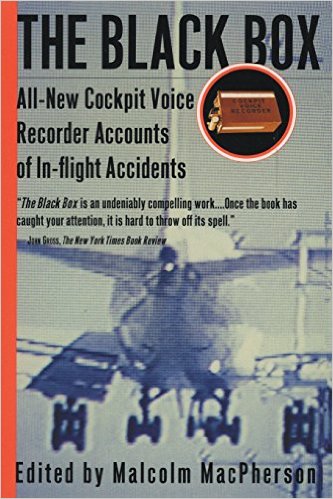
|
REVIEW
This is an interesting and hard read. The last words of many pilots and personnel who died in plane crashes, and what caused those crashes. Don’t recall why I bought this, but it was interesting. Let's face it, we all want to know what is going on up front in the plane; particularly at the last minutes before a crash. Its interesting to hear how they handled the situation, usually, right up to the point of impact.
Readers join desperate pilots in the cockpit as they fight gravity and time in a plane that's falling out of the sky.
Anyone who watches the news knows about the "black box." Officially called the cockpit voice recorder, the black box (which is actually Day-glo orange) records the final moments of any in-flight accident. Often it provides the only explanation of a crash -- inevitably, it provides a heart-breaking, second-by-second account of intense fear tempered by unyielding professionalism.
This 1984 Quill title has been completely updated to include twenty-eight new incidents occurring between 1978 and 1996. Some are famous, like the 1996 Valujet crash in the Everglades and the ill-fated launch of the space shuttle Challenger; other disasters range from commuter prop aircraft to jumbo airliners and a pair of Air Force planes. Few have ever been revealed in their entirety, each, without exception, is absolutely gripping.
In this new edition, editor Malcolm MacPherson has, wherever possible, added weather notes and descriptions of events in the cockpit and cabin, heightening our vivid sense of being there during the final moments. Provided by the National Transportation Safety Board and vetted by an experienced airline captain, these are unforgettable case studies in ultimate emergency -- authentic, immediate, filled with drama, terror, human frailty and error, and unquenchable courage.
SUMMARY
Readers join desperate pilots in the cockpit as they fight gravity and time in a plane that's falling out of the sky.
Anyone who watches the news knows about the "black box." Officially called the cockpit voice recorder, the black box (which is actually Day-glo orange) records the final moments of any in-flight accident. Often it provides the only explanation of a crash -- inevitably, it provides a heart-breaking, second-by-second account of intense fear tempered by unyielding professionalism.
This 1984 Quill title has been completely updated to include twenty-eight new incidents occurring between 1978 and 1996. Some are famous, like the 1996 Valujet crash in the Everglades and the ill-fated launch of the space shuttle Challenger; other disasters range from commuter prop aircraft to jumbo airliners and a pair of Air Force planes. Few have ever been revealed in their entirety, each, without exception, is absolutely gripping.
In this new edition, editor Malcolm MacPherson has, wherever possible, added weather notes and descriptions of events in the cockpit and cabin, heightening our vivid sense of being there during the final moments. Provided by the National Transportation Safety Board and vetted by an experienced airline captain, these are unforgettable case studies in ultimate emergency -- authentic, immediate, filled with drama, terror, human frailty and error, and unquenchable courage.
|
|
| 57 |
Maher, Bill
(1) |
|
When You Ride Alone You Ride With Bin Laden: What the Government Should Be Telling Us to Help Fight the War on Terrorism(Comedy)

|

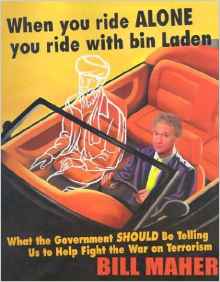
|
REVIEW
Bill Maher is a pretty controversial fellow. I don't agree with everything he says, but in this book is RIGHT ON THE MONEY!!! The title is a reference to an old WWII poster that said, "When you ride alone you ride with Hitler." - meaning that everyone needs to conserve gas to help the war effort. If it was true then, it's even more true now. But the American people have not been asked to sacrifice a single thing... NOTHING to winning the so-called "War on Terror". Bill rants intelligently about Profiling, Our Fuel Economy, Terrorism.. and everything linked to the insanity that George Bush imposed on this country for 8 years. And he does so with his own style of abrasive wit... that I happen to really like.
SUMMARY
Political provocateur Bill Maher tells it like it is in a useful and hilarious guide for the many Americans who want to do more here at home to help the war effort, but are at a loss as to what. Thirty-three dynamic new posters and several classics from our government's archive accompanied by text from one of our leading pundits and cutting-edge comedians make this the perfect book for this time in our nation's history, the zeitgeist of post-9/11 America. This is the book that will help Americans make connections between what we do and how it can help (or hurt) our troops and us.
|
|
| 58 |
Mayer, Kathleen
(1) |
|
How to Shit in the Woods: An Environmentally Sound Approach to a Lost Art(Instructional)

|

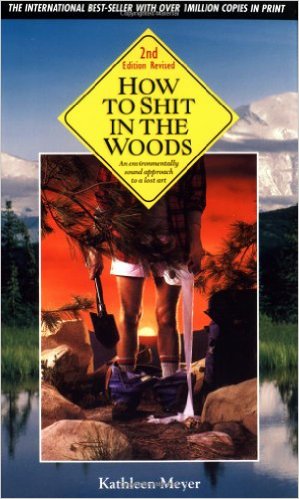
|
REVIEW
Hey, it’s a skill we all should know.
SUMMARY
The author continues to expand her investigation into better methods of conduct in the outdoors, reviews health concerns, and shares some of the extraordinary mail her book has generated.
|
|
| 59 |
McWilliams, Peter
(1) |

|

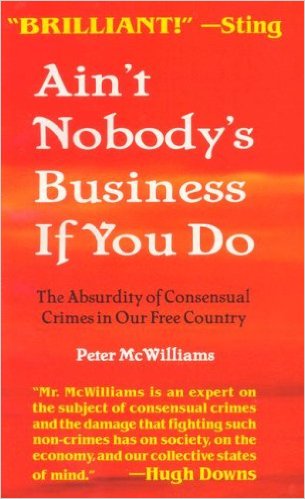
|
REVIEW
This is a great book about victim less crimes, and how laws against them make no sense. It’s a thick book, but divided up into various sections based on various crimes. Each presents a great argument as to why it should not be a crime; how it got to be a crime; the negative effects that criminalization has.
SUMMARY
A refresher course on rights and personal freedom. What is your position on prostitution, pornography, gambling and other victimless crimes? This book will make readers consider their rights and the rights of others in a more humanistic and caring way.
|
|
| 60 |
Meadows, D.H.
(1) |

|

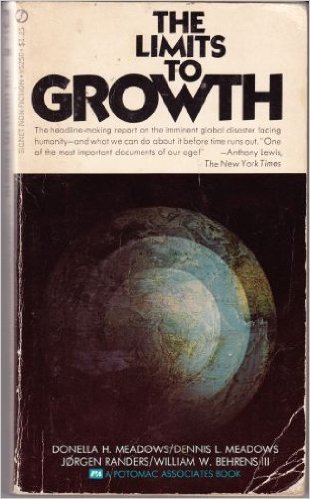
|
REVIEW
I had to read this for a course in college, and I have to say it's one of the few assigned books that I found totally gripping. Basically it was predicting that by the time I reached 45 the world was going to collapse. Not good news. The feedback systems of the planet, the out of control population growth, the demand and eventual scarcity of resources was going to be bad news for mankind in a few years.. Well, they were wrong, but only just. Global warming IS going to wreck havoc, and the world's oil based economy is going to come crashing down. But apparently improvements in food production and manufacturing have staved off their predictions for a while. I give this 2 stars because... for now.. it's fairly out of date. There is an updated version, but I have not read it.
SUMMARY
The headline-making report on the imminent global disaster facing humanity - and what we can do about it before time runs out. The book that launched the environmental movement globally.
|
|
| 61 |
Menager, Arlin D.
(1) |
|
Embalming is Not a Sport(Biography)

|

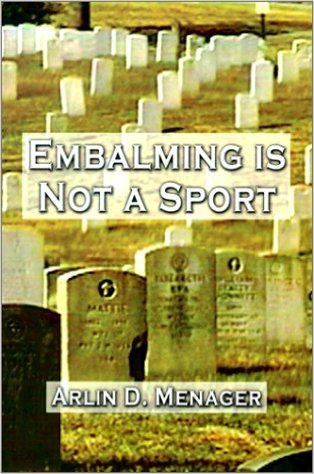
|
REVIEW
This is a very strange book. Arlin Menager tells how he became an embalmer in Vietnam - preparing bodies to be shipped home. He talks about the techniques he used and the challenges he had to figure out (like how do you embalm a body that is burnt to a crisp with no way to get the embalming fluids into the body). If you are squeamish, don't read this.
And then the book gets really strange. On his return he opens a funeral parlor and talks about the business. How he had trouble with employees. How he got married. How everyone in his life died and he, himself, took care of their bodies. Urrghhh. It is hard to read. Very Very strange. I don't know what his point was in writing this book. Maybe it was therapy, but this is really strange.
SUMMARY
Menager entered the Army at the age of 17. He retired from the U.S. Army after serving twenty years of active duty, which included two tours of duty in Viet Nam. He served his apprenticeship as an embalmer in a Funeral Home in Southern California.
|
|
| 62 |
Miller, Allen S.
(1) |
|
Why Beautiful People Have More Daughters(Science - Evolutionary Psychology)
UNRATED
|

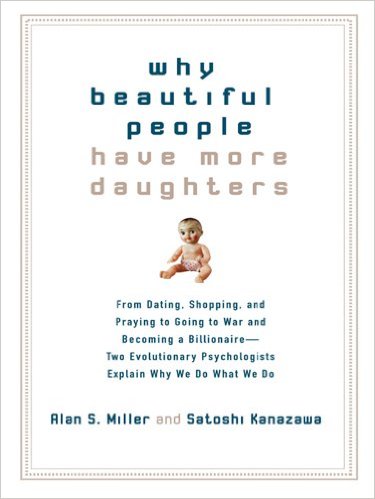
|
REVIEW
This is a nice intro to Evolutionary Psychology if you are looking for one. References all the classics in this field. The format of the book is a series of questions (Why does having sons reduce the risk of divorce? Why are diamonds a girls best friennd? Why are most suicide bombers Muslim?) Each is answers based on studies in psychology that lend themselves to an evol. psych. interpretation. Its all pretty mild stuff.. you don't need a degree to read it. And.. just to be fair, they ask a number of questions that evol. psych have no answer to .. yet. If you have any interest in this I recommend it.
Why are most neurosurgeons male and most kindergarten teachers female? Why aren?t there more women on death row? Why do so many male politicians ruin their careers with sex scandals? Why and how do we really fall in love? This engaging book uses the latest research from the field of evolutionary psychology to shed light on why we do the things we do?from life plans to everyday decisions. With a healthy disregard for political correctness, Miller and Kanazawa reexamine the fact that our brains and bodies are hardwired to carry out an evolutionary mission? an inescapable human nature that actually stopped evolving about 10,000 years ago.
SUMMARY
Why are most neurosurgeons male and most kindergarten teachers female? Why aren?t there more women on death row? Why do so many male politicians ruin their careers with sex scandals? Why and how do we really fall in love? This engaging book uses the latest research from the field of evolutionary psychology to shed light on why we do the things we do?from life plans to everyday decisions. With a healthy disregard for political correctness, Miller and Kanazawa reexamine the fact that our brains and bodies are hardwired to carry out an evolutionary mission? an inescapable human nature that actually stopped evolving about 10,000 years ago.
|
|
| 63 |
Miller, Geoffrey
(1) |


|

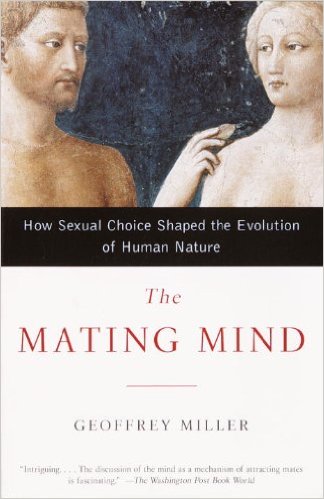
|
REVIEW
This is a great introduction to evolutionary psychology. It has breadth and depth. For example, it explains the two sexual strategies that humans pursue and from this offers theories on how ART, and MUSIC, and LITERATURE and even SPORTS came into being as a direct result. It offers a theory of how language developed, and how it became so complex. Of why we feel compelled to create art and write poetry. Why we have wars and enjoy sports. All this, as Robin Williams once said, "To woe women."
SUMMARY
At once a pioneering study of evolution and an accessible and lively reading experience, The Mating Mind marks the arrival of a prescient and provocative new science writer. Psychologist Geoffrey Miller offers the most convincing–and radical–explanation for how and why the human mind evolved.
Consciousness, morality, creativity, language, and art: these are the traits that make us human. Scientists have traditionally explained these qualities as merely a side effect of surplus brain size, but Miller argues that they were sexual attractors, not side effects. He bases his argument on Darwin's theory of sexual selection, which until now has played second fiddle to Darwin's theory of natural selection, and draws on ideas and research from a wide range of fields, including psychology, economics, history, and pop culture. Witty, powerfully argued, and continually thought-provoking, The Mating Mind is a landmark in our understanding of our own species.
|
|
| 64 |
Mueller, Rober
(1) |

|

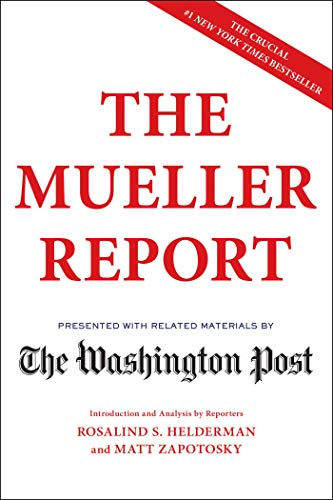
|
REVIEW
I will state right off the bat, I DID NOT read this entire tome. However, there is so much great information in here. And the American people are STILL ignorant about it.
People are still convinced that the Russians did nothing to interfere with the election. READ THE INDICTMENTS. They spent money. They setup rallies. The paid for influence.. and I'm not talking about Facebook (though they did that too). The did a lot to influence Americans to vote for Trump. To say they didn't is WILLFUL IGNORANCE. (I can forgive ignorance, but I cannot forgive willful ignorance).
This is NOT hard to read. You do NOT have to be a lawyer. You can pick and chose to find the facts you want.. it is very damning. And remember, TRUMP never cooperated with this investigation, so we will probably never know all the facts.
SUMMARY
ONE OF TIME’S 100 BEST BOOKS OF THE YEAR
The Crucial #1 New York Times Bestseller
“The Mueller report is that rare Washington tell-all that surpasses its pre-publication hype…the best book by far on the workings of the Trump presidency.” —Carlos Lozada, The Washington Post
The only book with exclusive analysis by the Pulitzer Prize–winning staff of The Washington Post, and the most complete and authoritative available.
Read the findings of the Special Counsel’s investigation into Russian interference in the 2016 election, complete with accompanying analysis by the Post reporters who’ve covered the story from the beginning.
This edition from The Washington Post/Scribner contains:
—The long-awaited Report On The Investigation Into Russian Interference In The 2016 Presidential Election
—An introduction by The Washington Post titled “A President, a Prosecutor, and the Protection of American Democracy”
—A timeline of the major events of the Special Counsel’s investigation from May 2017, when Robert Mueller was appointed, to the report's delivery
—A guide to individuals involved, including in the Special Counsel’s Office, the Department of Justice, the FBI, the Trump Campaign, the White House, the Trump legal defense team, and the Russians
—Key documents in the Special Counsel’s investigation, including filings pertaining to General Michael T. Flynn, Paul Manafort, Michael Cohen, Roger Stone, and the Russian internet operation in St. Petersburg. Each document is introduced and explained by Washington Post reporters.
One of the most urgent and important investigations ever conducted, the Mueller inquiry focuses on Donald Trump, his presidential campaign, and Russian interference in the 2016 election, and draws on the testimony of dozens of witnesses and the work of some of the country’s most seasoned prosecutors.
The special counsel’s investigation looms as a turning point in American history. The Mueller Report is essential reading for all citizens concerned about the fate of the presidency and the future of our democracy.
|
|
| 65 |
Orlean, Susan
(1) |

|

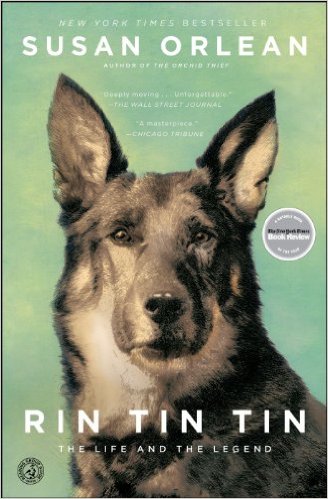
|
REVIEW
If you grew up watching Rin Tin Tin, then this will be an interesting read. Apparently there were several Rin Tin Tin's starting with the first - a dog who was rescued on a World War I battle field, and who grew to become the first (and only) winner of an Academy Award (that is until they decided that they just could not give the award to an animal - sigh). A fun read.
SUMMARY
He believed the dog was immortal. So begins Susan Orlean's sweeping, powerfully moving account of Rin Tin Tin's journey from abandoned puppy to movie star and international icon. Spanning almost one hundred years of history, from the dog's improbable discovery on a battlefield in 1918 to his tumultuous rise through Hollywood and beyond, Rin Tin Tin is a love story about "the mutual devotion between one man and one dog" (The Wall Street Journal) that is also a quintessentially American story of reinvention, a captivating exploration of our spiritual bond with animals, and a stirring meditation on mortality and immortality.
|
|
| 66 |
Philbrick, Nathaniel
(1) |
|
In the Heart of the Sea: The Tragedy of the Whaleship Essex(History)


 |

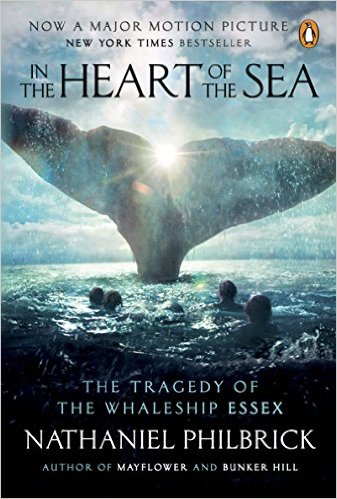
|
REVIEW
The Essex is the ship on which Herman Melville based the novel Moby Dick. The story of the Essex, however, is true. It was a whaleship out of Nantucket that was rammed by a whale and sunk. This book explores the Nantucket whaling culture, the lives of whale ships, and "fishie" men, and the particular story of the last voyage of the Essex and how some of the crew managed to survive to tell the tale. I have to admit that since Moby Dick is my favorite book of all time that discovering that there was a real ship on which that story was based just blew me away. This was a great read. But, take my recommendation with a grain of salt (pun intended).. if history and stories of immense suffering (including cannibalism) is not your cup of tea, you might want to pass this by. But I loved it.
SUMMARY
Soon to be a major motion picture starring Chris Hemsworth, Cillian Murphy, Ben Wishaw, and Brendan Gleeson, and directed by Ron Howard. The ordeal of the whaleship Essex was an event as mythic in the nineteenth century as the sinking of the Titanic was in the twentieth. In 1819, the Essex left Nantucket for the South Pacific with twenty crew members aboard. In the middle of the South Pacific the ship was rammed and sunk by an angry sperm whale. The crew drifted for more than ninety days in three tiny whaleboats, succumbing to weather, hunger, disease, and ultimately turning to drastic measures in the fight for survival. Nathaniel Philbrick uses little-known documents-including a long-lost account written by the ship's cabin boy-and penetrating details about whaling and the Nantucket community to reveal the chilling events surrounding this epic maritime disaster. An intense and mesmerizing read, In the Heart of the Sea is a monumental work of history forever placing the Essex tragedy in the American historical canon.
|
|
| 67 |
Pinker, Steven
(2) |


|

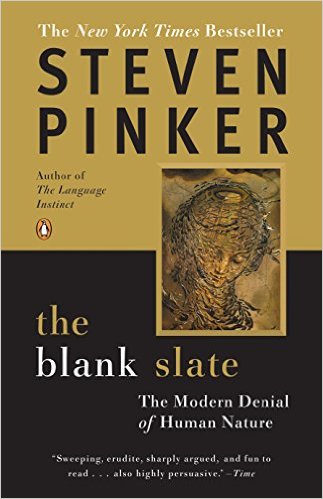
|
REVIEW
This is the same author mentioned in another section. This book is more of a philosophy book than a psychology book, but I put it here because the author is making the claim that you can arrive at human nature and morality without claiming any sort of supernatural or higher law that is outside the realm of human psychology. He makes the arguments that various philosophical ideas from the past (tabula rasa for example) had negative effects on moral thinking, and the they were just plain wrong.
SUMMARY
In The Blank Slate, Steven Pinker, one of the world's leading experts on language and the mind, explores the idea of human nature and its moral, emotional, and political colorings. With characteristic wit, lucidity, and insight, Pinker argues that the dogma that the mind has no innate traits-a doctrine held by many intellectuals during the past century-denies our common humanity and our individual preferences, replaces objective analyses of social problems with feel-good slogans, and distorts our understanding of politics, violence, parenting, and the arts. Injecting calm and rationality into debates that are notorious for ax-grinding and mud-slinging, Pinker shows the importance of an honest acknowledgment of human nature based on science and common sense.
|
|
| 68 |
Pinker, Steven
(2) |


|

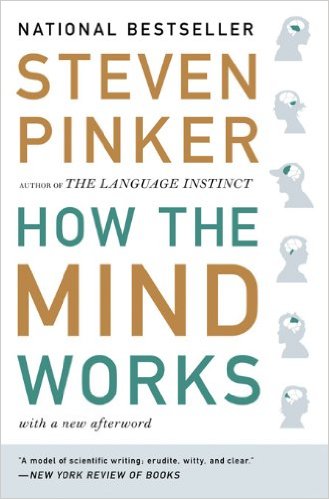
|
REVIEW
This is a great book if you want to understand where human psychology comes from. Psychology being the study of human behavior as it relates to the individual... and it all takes place in the "mind" so you better know what the mind is and how it works. This book does well with explaining various mental sub-systems and how these come together to create what we call our mind.. or ourselves.
SUMMARY
In this Pulitzer Prize finalist and national bestseller, one of the world's leading cognitive scientists tackles the workings of the human mind. What makes us rational—and why are we so often irrational? How do we see in three dimensions? What makes us happy, afraid, angry, disgusted, or sexually aroused? Why do we fall in love? And how do we grapple with the imponderables of morality, religion, and consciousness? ?How the Mind Works? synthesizes the most satisfying explanations of our mental life from cognitive science, evolutionary biology, and other fields to explain what the mind is, how it evolved, and how it allows us to see, think, feel, laugh, interact, enjoy the arts, and contemplate the mysteries of life
|
|
| 69 |
Pirsig, Robert M.
(1) |

|

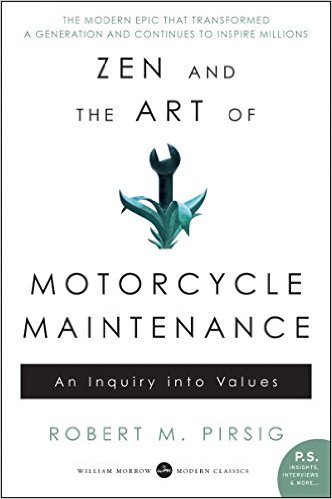
|
REVIEW
I read this so long ago, that I believe I have to re-read it to give it a proper review. All I can remember from the first reading (early in High School) was that the book was an easy read, and had a calming effect.
SUMMARY
One of the most important and influential books written in the past half-century, Robert M. Pirsig's Zen and the Art of Motorcycle Maintenance is a powerful, moving, and penetrating examination of how we live . . . and a breathtaking meditation on how to live better. Here is the book that transformed a generation: an unforgettable narration of a summer motorcycle trip across America's Northwest, undertaken by a father and his young son. A story of love and fear -- of growth, discovery, and acceptance -- that becomes a profound personal and philosophical odyssey into life's fundamental questions, this uniquely exhilarating modern classic is both touching and transcendent, resonant with the myriad confusions of existence . . . and the small, essential triumphs that propel us forward.
|
|
| 70 |
Ridley, Matt
(5) |

|

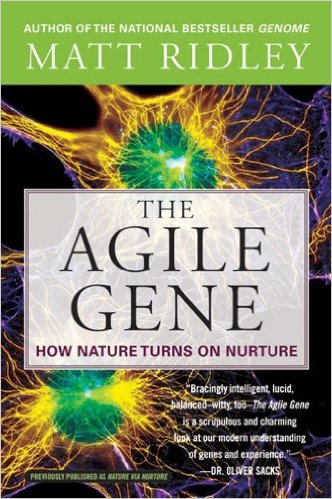
|
REVIEW
Ridley explains that, though our genes control much of who we become, sometimes, who we become controls how are genes work. We all have a nature, but environmental factors will shape the way our genes operate to adapt to that environment. Interesting.
SUMMARY
Armed with extraordinary new discoveries about our genes, acclaimed science writer Matt Ridley turns his attention to the nature-versus-nurture debate in a thoughtful book about the roots of human behavior.
Ridley recounts the hundred years' war between the partisans of nature and nurture to explain how this paradoxical creature, the human being, can be simultaneously free-willed and motivated by instinct and culture. With the decoding of the human genome, we now know that genes not only predetermine the broad structure of the brain, they also absorb formative experiences, react to social cues, and even run memory. They are consequences as well as causes of the will
|
|
| 71 |
Ridley, Matt
(5) |

|


|
REVIEW
There are 23 chromosomes that make up a human being. This book takes each on of these and explores one set of genes on that chromosome, and how they affect the way we live and behave. It explores how genes interact with other genes, and how we have these in common with other creatures, and the role they play in all of us. It makes you realize that you only need a little twist here.. a little shove there, and the whole animal changes, or dies, or has some illness that cannot be cured. A good light introduction to genes and what they do for you.
SUMMARY
The genome's been mapped.
But what does it mean?
Arguably the most significant scientific discovery of the new century, the mapping of the twenty-three pairs of chromosomes that make up the human genome raises almost as many questions as it answers. Questions that will profoundly impact the way we think about disease, about longevity, and about free will. Questions that will affect the rest of your life.
Genome offers extraordinary insight into the ramifications of this incredible breakthrough. By picking one newly discovered gene from each pair of chromosomes and telling its story, Matt Ridley recounts the history of our species and its ancestors from the dawn of life to the brink of future medicine. From Huntington's disease to cancer, from the applications of gene therapy to the horrors of eugenics, Matt Ridley probes the scientific, philosophical, and moral issues arising as a result of the mapping of the genome. It will help you understand what this scientific milestone means for you, for your children, and for humankind.
|
|
| 72 |
Ridley, Matt
(5) |

|

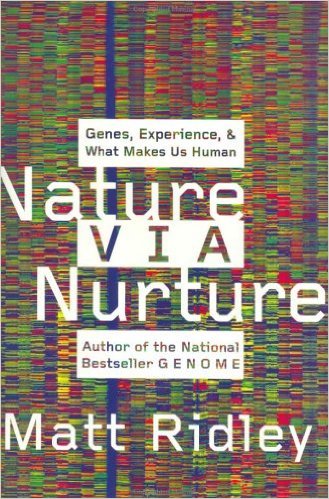
|
REVIEW
Is it NURTURE or NATURE that governs who we turn out to be. Ridley says it's both, and that our genes are actually affected by our environment. We have over 30,000 gene's that can switch on or off based on environmental cues. It makes sense that we should have some adaptability to our environment built into us as animals. This is another great book by a great author, and one I would recommend to everyone who has ever wondered about Nature vs. Nurture.
Following his highly praised and bestselling book Genome: The Autobiography of a Species in 23 Chapters, Matt Ridley has written a brilliant and profound book about the roots of human behavior. Nature via Nurture explores the complex and endlessly intriguing question of what makes us who we are.
In February 2001 it was announced that the human genome contains not 100,000 genes, as originally postulated, but only 30,000. This startling revision led some scientists to conclude that there are simply not enough human genes to account for all the different ways people behave: we must be made by nurture, not nature. Yet again biology was to be stretched on the Procrustean bed of the nature-nurture debate. Matt Ridley argues that the emerging truth is far more interesting than this myth. Nurture depends on genes, too, and genes need nurture. Genes not only predetermine the broad structure of the brain, they also absorb formative experiences, react to social cues, and even run memory. They are consequences as well as causes of the will.
Published fifty years after the discovery of the double helix of DNA, Nature via Nurture chronicles a revolution in our understanding of genes. Ridley recounts the hundred years' war between the partisans of nature and nurture to explain how this paradoxical creature, the human being, can be simultaneously free-willed and motivated by instinct and culture. Nature via Nurture is an enthralling,up-to-the-minute account of how genes build brains to absorb experience.
SUMMARY
Following his highly praised and bestselling book Genome: The Autobiography of a Species in 23 Chapters, Matt Ridley has written a brilliant and profound book about the roots of human behavior. Nature via Nurture explores the complex and endlessly intriguing question of what makes us who we are.
In February 2001 it was announced that the human genome contains not 100,000 genes, as originally postulated, but only 30,000. This startling revision led some scientists to conclude that there are simply not enough human genes to account for all the different ways people behave: we must be made by nurture, not nature. Yet again biology was to be stretched on the Procrustean bed of the nature-nurture debate. Matt Ridley argues that the emerging truth is far more interesting than this myth. Nurture depends on genes, too, and genes need nurture. Genes not only predetermine the broad structure of the brain, they also absorb formative experiences, react to social cues, and even run memory. They are consequences as well as causes of the will.
Published fifty years after the discovery of the double helix of DNA, Nature via Nurture chronicles a revolution in our understanding of genes. Ridley recounts the hundred years' war between the partisans of nature and nurture to explain how this paradoxical creature, the human being, can be simultaneously free-willed and motivated by instinct and culture. Nature via Nurture is an enthralling,up-to-the-minute account of how genes build brains to absorb experience.
|
|
| 73 |
Ridley, Matt
(5) |


|

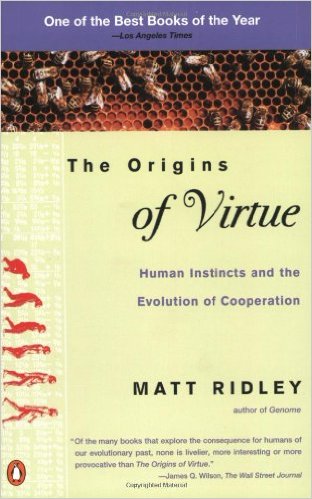
|
REVIEW
Another great book from Matt Ridley. Amazingly readable for a subject that can be pretty complicated. (He does get a little dense when talking about variations of the prisoner's dilemma and the Tit-for-Tat strategies and modifications thereof.) Answers the question of how morality and our feelings of fairness managed to evolve when supposedly the best strategy for anyone is every-man-for-himself. Covered in bits and pieces in other books but nicely summarized here.
If, as Darwin suggests, evolution relentlessly encourages the survival of the fittest, why are humans compelled to live in cooperative, complex societies? In this fascinating examination of the roots of human trust and virtue, a zoologist and former American editor of the Economist reveals the results of recent studies that suggest that self-interest and mutual aid are not at all incompatible. In fact, he points out, our cooperative instincts may have evolved as part of mankind?s natural selfish behavior--by exchanging favors we can benefit ourselves as well as others.Brilliantly orchestrating the newest findings of geneticists, psychologists, and anthropologists, The Origins of Virtue re-examines the everyday assumptions upon which we base our actions towards others, whether in our roles as parents, siblings, or trade partners. With the wit and brilliance of The Red Queen, his acclaimed study of human and animal sexuality, Matt Ridley shows us how breakthroughs in computer programming, microbiology, and economics have given us a new perspective on how and why we relate to each other.
SUMMARY
If, as Darwin suggests, evolution relentlessly encourages the survival of the fittest, why are humans compelled to live in cooperative, complex societies? In this fascinating examination of the roots of human trust and virtue, a zoologist and former American editor of the Economist reveals the results of recent studies that suggest that self-interest and mutual aid are not at all incompatible. In fact, he points out, our cooperative instincts may have evolved as part of mankind?s natural selfish behavior--by exchanging favors we can benefit ourselves as well as others.Brilliantly orchestrating the newest findings of geneticists, psychologists, and anthropologists, The Origins of Virtue re-examines the everyday assumptions upon which we base our actions towards others, whether in our roles as parents, siblings, or trade partners. With the wit and brilliance of The Red Queen, his acclaimed study of human and animal sexuality, Matt Ridley shows us how breakthroughs in computer programming, microbiology, and economics have given us a new perspective on how and why we relate to each other.
|
|
| 74 |
Ridley, Matt
(5) |


|

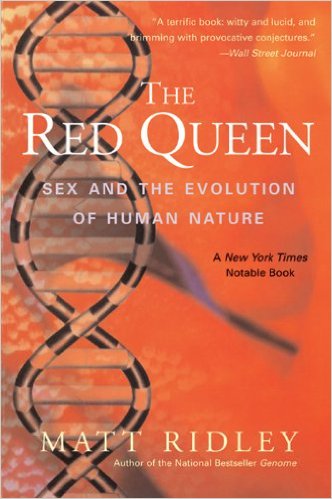
|
REVIEW
The problem with evolution is that, like the Red Queen in Alice in Wonderland, you have to run as fast as you can just to stay in one place. If you want to get anywhere you have to run faster. The same is true when it comes to the sexual motivations of any species, including humans. As far as sex goes, humans can be treated as two separate species that each pursues the mating strategy that is most successful for them with an opposite sex that is NOT motivated by the same thing. This is a good read.
SUMMARY
Referring to Lewis Carroll's Red Queen from Through the Looking-Glass, a character who has to keep running to stay in the same place, Matt Ridley demonstrates why sex is humanity's best strategy for outwitting its constantly mutating internal predators. The Red Queen answers dozens of other riddles of human nature and culture -- including why men propose marriage, the method behind our maddening notions of beauty, and the disquieting fact that a woman is more likely to conceive a child by an adulterous lover than by her husband. Brilliantly written, The Red Queen offers an extraordinary new way of interpreting the human condition and how it has evolved.
|
|
| 75 |
Roach, Mary
(3) |

|


|
REVIEW
Mary Roach is a funny writer. Her footnotes are simply a hoot. And this book contains plenty of little known and down-right strange facts about the science of sex. But it's just not up to her previous book STIFF. If you have to read one of these first.. read STIFF... then read BONK.
In ?Bonk, ?the best-selling author of Stiff turns her outrageous curiosity and insight on the most alluring scientific subject of all: sex. Can a person think herself to orgasm? Why doesn't Viagra help women-or, for that matter, pandas? Can a dead man get an erection? Is vaginal orgasm a myth? Mary Roach shows us how and why sexual arousal and orgasm-two of the most complex, delightful, and amazing scientific phenomena on earth-can be so hard to achieve and what science is doing to make the bedroom a more satisfying place. 16 illustrations
SUMMARY
In ?Bonk, ?the best-selling author of Stiff turns her outrageous curiosity and insight on the most alluring scientific subject of all: sex. Can a person think herself to orgasm? Why doesn't Viagra help women-or, for that matter, pandas? Can a dead man get an erection? Is vaginal orgasm a myth? Mary Roach shows us how and why sexual arousal and orgasm-two of the most complex, delightful, and amazing scientific phenomena on earth-can be so hard to achieve and what science is doing to make the bedroom a more satisfying place.
|
|
| 76 |
Roach, Mary
(3) |

|

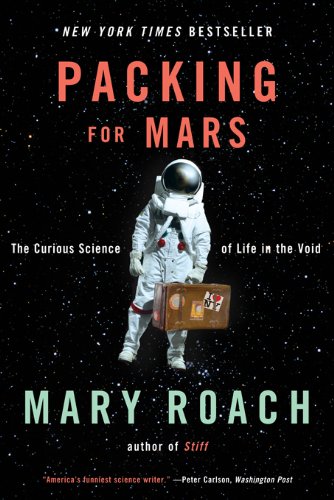
|
REVIEW
This book explores a whole bunch of issues involved in space travel.. that you won't find any where else. How do you handle vomit in space? How do you take a dump? Who does that kind of research? How do they do it? What about food? Does it have to taste good? What kind of food produces less .. er.. waste? How do you research this stuff? How do you get clean in space.. a show won't work. Can you burp in space? What happens when you fart?
You're not gonna read this any place else. Some parts of this book should not be read while you are eating.. but the whole thing is interesting. Another hit by Mary Roach.
SUMMARY
Space is a world devoid of the things we need to live and thrive: air, gravity, hot showers, fresh produce, privacy, beer. Space exploration is in some ways an exploration of what it means to be human. How much can a person give up? How much weirdness can they take? What happens to you when you can?t walk for a year? have sex? smell flowers? What happens if you vomit in your helmet during a space walk? Is it possible for the human body to survive a bailout at 17,000 miles per hour? To answer these questions, space agencies set up all manner of quizzical and startlingly bizarre space simulations. As Mary Roach discovers, it?s possible to preview space without ever leaving Earth. From the space shuttle training toilet to a crash test of NASA?s new space capsule (cadaver filling in for astronaut), Roach takes us on a surreally entertaining trip into the science of life in space and space on Earth.
|
|
| 77 |
Roach, Mary
(3) |


|

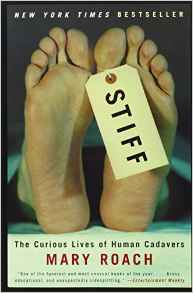
|
REVIEW
There are so many more options regarding what to do with a human body other then burn or bury. You could contribute it to “science” – which might get you dissected; left out in the woods to study decomposition; get your head cut off so plastic surgeons can practice new techniques; used in so many squeamish ways over which you have no control that it will make your head spin. If you can stomach it, this is an interesting book.
Stiff is an oddly compelling, often hilarious exploration of the strange lives of our bodies postmortem. For two thousand years, cadavers?some willingly, some unwittingly?have been involved in science's boldest strides and weirdest undertakings. In this fascinating account, Mary Roach visits the good deeds of cadavers over the centuries and tells the engrossing story of our bodies when we are no longer with them.
SUMMARY
Stiff is an oddly compelling, often hilarious exploration of the strange lives of our bodies postmortem. For two thousand years, cadavers?some willingly, some unwittingly?have been involved in science's boldest strides and weirdest undertakings. In this fascinating account, Mary Roach visits the good deeds of cadavers over the centuries and tells the engrossing story of our bodies when we are no longer with them.
|
|
| 78 |
Royte, Elizabeth
(1) |
|
Garbage Land: On the Secret Trail of Trash(Science - General)


|

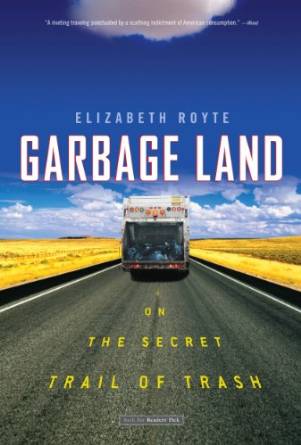
|
REVIEW
One woman’s quest to find out where her garbage goes. Ms. Royte literally followed it from her front curb to all the places it ends up. It’s surprising where it goes; who handles it; how it is handled; and what we are ultimately going to do about the growing trash problem in this country. It was also an exercise in trash reduction - what kinds of reductions are meaningful, and what aren't. An easy read, and fun to boot.
Out of sight, out of mind ... Into our trash cans go dead batteries, dirty diapers, bygone burritos, broken toys, tattered socks, eight-track cassettes, scratched CDs, banana peels.... But where do these things go next? In a country that consumes and then casts off more and more, what actually happens to the things we throw away? In Garbage Land, acclaimed science writer Elizabeth Royte leads us on the wild adventure that begins once our trash hits the bottom of the can. Along the way, we meet an odor chemist who explains why trash smells so bad; garbage fairies and recycling gurus; neighbors of massive waste dumps; CEOs making fortunes by encouraging waste or encouraging recycling-often both at the same time; scientists trying to revive our most polluted places; fertilizer fanatics and adventurers who kayak amid sewage; paper people, steel people, aluminum people, plastic people, and even a guy who swears by recycling human waste. With a wink and a nod and a tightly clasped nose, Royte takes us on a bizarre cultural tour through slime, stench, and heat-in other words, through the back end of our ever-more supersized lifestyles. By showing us what happens to the things we've "disposed of," Royte reminds us that our decisions about consumption and waste have a very real impact-and that unless we undertake radical change, the garbage we create will always be with us: in the air we breathe, the water we drink, and the food we consume. Radiantly written and boldly reported, Garbage Land is a brilliant exploration into the soiled heart of the American trash can.
SUMMARY
Out of sight, out of mind ... Into our trash cans go dead batteries, dirty diapers, bygone burritos, broken toys, tattered socks, eight-track cassettes, scratched CDs, banana peels.... But where do these things go next? In a country that consumes and then casts off more and more, what actually happens to the things we throw away? In Garbage Land, acclaimed science writer Elizabeth Royte leads us on the wild adventure that begins once our trash hits the bottom of the can. Along the way, we meet an odor chemist who explains why trash smells so bad; garbage fairies and recycling gurus; neighbors of massive waste dumps; CEOs making fortunes by encouraging waste or encouraging recycling-often both at the same time; scientists trying to revive our most polluted places; fertilizer fanatics and adventurers who kayak amid sewage; paper people, steel people, aluminum people, plastic people, and even a guy who swears by recycling human waste. With a wink and a nod and a tightly clasped nose, Royte takes us on a bizarre cultural tour through slime, stench, and heat-in other words, through the back end of our ever-more supersized lifestyles. By showing us what happens to the things we've "disposed of," Royte reminds us that our decisions about consumption and waste have a very real impact-and that unless we undertake radical change, the garbage we create will always be with us: in the air we breathe, the water we drink, and the food we consume. Radiantly written and boldly reported, Garbage Land is a brilliant exploration into the soiled heart of the American trash can.
|
|
| 79 |
Sagan, Carl
(2) |
|
The Demon-Haunted World: Science as a Candle in the Dark(Science - General)

|

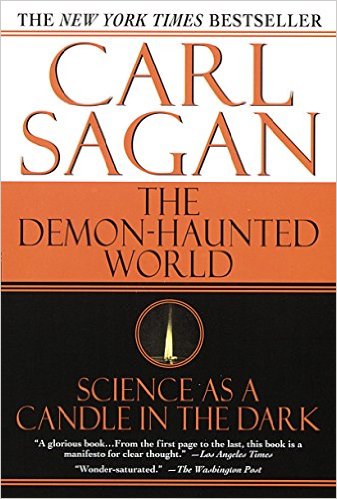
|
REVIEW
Carl Sagan muses on the current state of scientific thought, which offers him marvelous opportunities to entertain us with his own childhood experiences, the newspaper morgues, UFO stories, and the assorted flotsam and jetsam of pseudoscience. Along the way he debunks alien abduction, faith-healing, and channeling; refutes the arguments that science destroys spirituality, and provides a "baloney detection kit" for thinking through political, social, religious, and other issues.
SUMMARY
How can we make intelligent decisions about our increasingly technology-driven lives if we don't understand the difference between the myths of pseudoscience and the testable hypotheses of science? Pulitzer Prize-winning author and distinguished astronomer Carl Sagan argues that scientific thinking is critical not only to the pursuit of truth but to the very well-being of our democratic institutions.
Casting a wide net through history and culture, Sagan examines and authoritatively debunks such celebrated fallacies of the past as witchcraft, faith healing, demons, and UFOs. And yet, disturbingly, in today's so-called information age, pseudoscience is burgeoning with stories of alien abduction, channeling past lives, and communal hallucinations commanding growing attention and respect. As Sagan demonstrates with lucid eloquence, the siren song of unreason is not just a cultural wrong turn but a dangerous plunge into darkness that threatens our most basic freedoms.
|
|
| 80 |
Sagan, Carl
(2) |

|

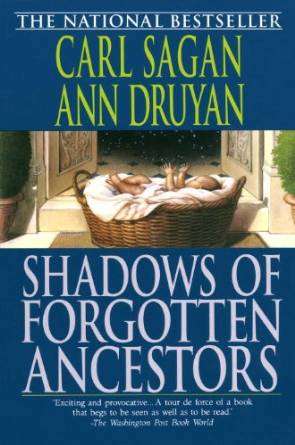
|
REVIEW
I was first attracted to the book because it purported to explain where racism comes from.... I had to read this. I thought I knew how evolution worked... I had the standard introduction to it in high school.. It made sense, but I anthropomorphized it like everyone has a tendency to do.. like there was a goal or a reason for it. This book cleared that up once and for all.. It also DID manage to explain the origins of racism. And believe it or not, racism was a beneficial evolutionary feature. It enhances the growth of the species!!! I was knocked out by this. It left me with a lot to think about. That racism is NOT a matter of education or up-bringing... it's a hard wired fact in our genetic and psychological make up. Of course, that does not justify it when the evolutionary advantage for it disappears. But it's amazing to see how it could be beneficial to evolution in general. We have many evolutionary triggers built into us. Some of which we consciously chose to ignore. This is one I think we should ignore. It just makes it more understandable WHY we have such a hard time as a species ignoring these impulses.
SUMMARY
"Dazzling...A feast. Absorbing and elegantly written, it tells of theorigins of life on earth, describes its variety and charaacter, and culminates in a discussion of human nature and teh complex traces ofhumankind's evolutionary past...It is an amazing story masterfully told."
FINANCIAL TIMES (LONDON)
World renowned scientist Carl Sagan and acclaimed author Ann Druyan have written a ROOTS for the human species, a lucid and riveting account of how humans got to be the way we are. It shows with humor and drama that many of our key traits--self-awareness, technology, family ties, submission to authority, hatred for those a little different from ourselves, reason, and ethics--are rooted in the deep past, and illuminated by our kinship with other animals. Astonishing in its scope, brilliant in its insights, and an absolutely compelling read, SHADOWS OF FORGOTTEN ANCESTORS is a triumph of popular science.
|
|
| 81 |
Schlosser, Eric
(2) |
|
Command and Control: Nuclear Weapons, the Damascus Accident, and the Illusion of Safety(History)


|

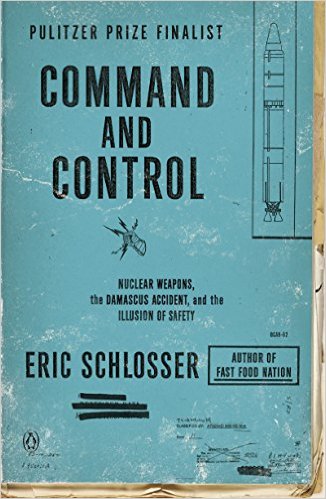
|
REVIEW
It is truly a wonder that we have not had a detonation of a nuclear device in this country by accident. When you read how many have been dropped, burned, mishandled, and down right LOST (Yes, lost) you will be amazed that we have not blown ourselves up many times over. The safety protocols put in place to handle nuclear weapons have proven woefully inadequate to the task, and it is only LUCK that has kept us safe.
The main story of this book is the Damascus Incident in which one of our nuclear missiles caught fire and blew up, sending the warhead through the silo roof and killing several people in the process. But this is just the one detailed incident - the book lists many many more.
Read this book and you will be amazed and terrified that this is still going on, even now.
SUMMARY
Famed investigative journalist Eric Schlosser digs deep to uncover secrets about the management of America's nuclear arsenal. A ground-breaking account of accidents, near-misses, extraordinary heroism, and technological breakthroughs, Command and Control explores the dilemma that has existed since the dawn of the nuclear age: how do you deploy weapons of mass destruction without being destroyed by them? That question has never been resolved--and Schlosser reveals how the combination of human fallibility and technological complexity still poses a grave risk to mankind.
Written with the vibrancy of a first-rate thriller, Command and Control interweaves the minute-by-minute story of an accident at a nuclear missile silo in rural Arkansas with a historical narrative that spans more than fifty years. It depicts the urgent effort by American scientists, policymakers, and military officers to ensure that nuclear weapons can't be stolen, sabotaged, used without permission, or detonated inadvertently. Schlosser also looks at the Cold War from a new perspective, offering history from the ground up, telling the stories of bomber pilots, missile commanders, maintenance crews, and other ordinary servicemen who risked their lives to avert a nuclear holocaust. At the heart of the book lies the struggle, amid the rolling hills and small farms of Damascus, Arkansas, to prevent the explosion of a ballistic missile carrying the most powerful nuclear warhead ever built by the United States.
Drawing on recently declassified documents and interviews with men who designed and routinely handled nuclear weapons, Command and Control takes readers into a terrifying but fascinating world that, until now, has been largely hidden from view. Through the details of a single accident, Schlosser illustrates how an unlikely event can become unavoidable, how small risks can have terrible consequences, and how the most brilliant minds in the nation can only provide us with an illusion of control. Audacious, gripping, and unforgettable, Command and Control is a tour de force of investigative journalism, an eye-opening look at the dangers of America's nuclear age.
|
|
| 82 |
Schlosser, Eric
(2) |


 |

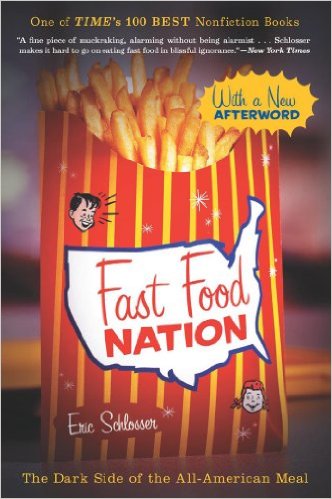
|
REVIEW
“There’s shit in the meat.” Literally. This book is not just about our nations obsession with fast food, but how the growth of the fast food industry has affected the way we grow, process, and look at food in general. A meat packer’s job used to be one where you could support a family for life, but since the growth of the Fast Food Nation it’s a complete dead end where you are most likely to retire when you lose a limb. How is our food processed? Who gets hurt in the process? How is it flavored? How is it marketed? (McDonald’s Corporation is the largest buyer of satellite imagery – just to figure out where to put the next McDonalds.) And how is our obsession with fast food affecting the rest of the world. If you start reading this, you won’t be putting it down anytime soon. Highly Recommended.
On any given day, one out of four Americans opts for a quick and cheap meal at a fast-food restaurant, without giving either its speed or its thriftiness a second thought. Fast food is so ubiquitous that it now seems as American, and harmless, as apple pie. But the industry's drive for consolidation, homogenization, and speed has radically transformed America's diet, landscape, economy, and workforce, often in insidiously destructive ways. Eric Schlosser, an award-winning journalist, opens his ambitious and ultimately devastating exposé with an introduction to the iconoclasts and high school dropouts, such as Harlan Sanders and the McDonald brothers, who first applied the principles of a factory assembly line to a commercial kitchen. Quickly, however, he moves behind the counter with the overworked and underpaid teenage workers, onto the factory farms where the potatoes and beef are grown, and into the slaughterhouses run by giant meatpacking corporations. Schlosser wants you to know why those French fries taste so good (with a visit to the world's largest flavor company) and "what really lurks between those sesame-seed buns." Eater beware: forget your concerns about cholesterol, there is--literally--feces in your meat.
Schlosser's investigation reaches its frightening peak in the meatpacking plants as he reveals the almost complete lack of federal oversight of a seemingly lawless industry. His searing portrayal of the industry is disturbingly similar to Upton Sinclair's The Jungle, written in 1906: nightmare working conditions, union busting, and unsanitary practices that introduce E. coli and other pathogens into restaurants, public schools, and homes. Almost as disturbing is his description of how the industry "both feeds and feeds off the young," insinuating itself into all aspects of children's lives, even the pages of their school books, while leaving them prone to obesity and disease. Fortunately, Schlosser offers some eminently practical remedies. "Eating in the United States should no longer be a form of high-risk behavior," he writes. Where to begin? Ask yourself, is the true cost of having it "your way" really worth it?
SUMMARY
"Schlosser has a flair for dazzling scene-setting and an arsenal of startling facts . . . Fast Food Nation points the way but, to resurrect an old fast food slogan, the choice is yours."—Los Angeles Times
In 2001, Fast Food Nation was published to critical acclaim and became an international bestseller. Eric Schlosser's exposé revealed how the fast food industry has altered the landscape of America, widened the gap between rich and poor, fueled an epidemic of obesity, and transformed food production throughout the world. The book changed the way millions of people think about what they eat and helped to launch today's food movement.
In a new afterword for this edition, Schlosser discusses the growing interest in local and organic food, the continued exploitation of poor workers by the food industry, and the need to ensure that every American has access to good, healthy, affordable food. Fast Food Nation is as relevant today as it was a decade ago. The book inspires readers to look beneath the surface of our food system, consider its impact on society and, most of all, think for themselves.
"As disturbing as it is irresistible . . . Exhaustively researched, frighteningly convincing . . . channeling the spirits of Upton Sinclair and Rachel Carson."—San Francisco Chronicle
"Schlosser shows how the fast food industry conquered both appetite and landscape."—The New Yorker
Eric Schlosser is a contributing editor for the Atlantic and the author of Fast Food Nation, Reefer Madness, and Chew on This (with Charles Wilson).
|
|
| 83 |
Shermer, Michael
(2) |

|

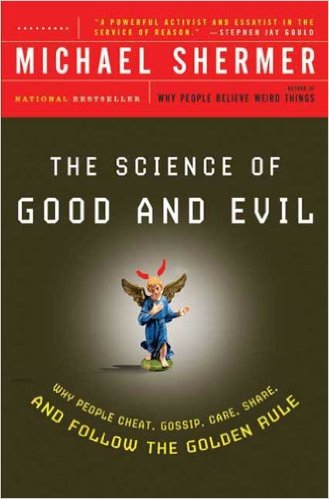
|
REVIEW
A century and a half after Darwin first proposed an "evolutionary ethics," science has begun to tackle the roots of morality. Just as evolutionary biologists study why we are hungry (to motivate us to eat) or why sex is enjoyable (to motivate us to procreate), they are now searching for the very nature of humanity.
In The Science of Good and Evil, science historian Michael Shermer explores how humans evolved from social primates to moral primates; how and why morality motivates the human animal; and how the foundation of moral principles can be built upon empirical evidence.
Along the way he explains the implications of scientific findings for fate and free will, the existence of pure good and pure evil, and the development of early moral sentiments among the first humans. As he closes the divide between science and morality, Shermer draws on stories from the Yanamamö, infamously known as the "fierce people" of the tropical rain forest, to the Stanford studies on jailers' behavior in prisons. The Science of Good and Evil is ultimately a profound look at the moral animal, belief, and the scientific pursuit of truth.
SUMMARY
From bestselling author Michael Shermer, an investigation of the evolution of morality that is "a paragon of popularized science and philosophy" The Sun (Baltimore)
A century and a half after Darwin first proposed an "evolutionary ethics," science has begun to tackle the roots of morality. Just as evolutionary biologists study why we are hungry (to motivate us to eat) or why sex is enjoyable (to motivate us to procreate), they are now searching for the very nature of humanity.
In The Science of Good and Evil, science historian Michael Shermer explores how humans evolved from social primates to moral primates; how and why morality motivates the human animal; and how the foundation of moral principles can be built upon empirical evidence.
Along the way he explains the implications of scientific findings for fate and free will, the existence of pure good and pure evil, and the development of early moral sentiments among the first humans. As he closes the divide between science and morality, Shermer draws on stories from the Yanamamö, infamously known as the "fierce people" of the tropical rain forest, to the Stanford studies on jailers' behavior in prisons. The Science of Good and Evil is ultimately a profound look at the moral animal, belief, and the scientific pursuit of truth.
|
|
| 84 |
Shermer, Michael
(2) |

|

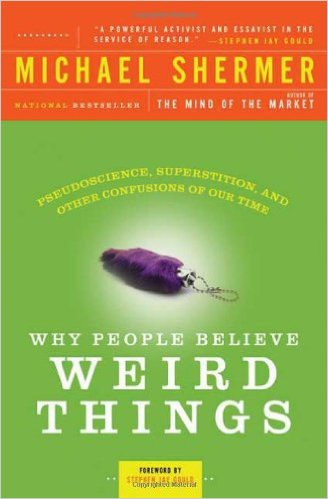
|
REVIEW
In this age of supposed scientific enlightenment, many people still believe in mind reading, past-life regression theory, New Age hokum, and alien abduction. A no-holds-barred assault on popular superstitions and prejudices, with more than 80,000 copies in print, Why People Believe Weird Things debunks these nonsensical claims and explores the very human reasons people find otherworldly phenomena, conspiracy theories, and cults so appealing. In an entirely new chapter, "Why Smart People Believe in Weird Things," Michael Shermer takes on science luminaries like physicist Frank Tippler and others, who hide their spiritual beliefs behind the trappings of science.
Shermer, science historian and true crusader, also reveals the more dangerous side of such illogical thinking, including Holocaust denial, the recovered-memory movement, the satanic ritual abuse scare, and other modern crazes. Why People Believe Strange Things is an eye-opening resource for the most gullible among us and those who want to protect them.
SUMMARY
In this age of supposed scientific enlightenment, many people still believe in mind reading, past-life regression theory, New Age hokum, and alien abduction. A no-holds-barred assault on popular superstitions and prejudices, with more than 80,000 copies in print, Why People Believe Weird Things debunks these nonsensical claims and explores the very human reasons people find otherworldly phenomena, conspiracy theories, and cults so appealing. In an entirely new chapter, "Why Smart People Believe in Weird Things," Michael Shermer takes on science luminaries like physicist Frank Tippler and others, who hide their spiritual beliefs behind the trappings of science.
Shermer, science historian and true crusader, also reveals the more dangerous side of such illogical thinking, including Holocaust denial, the recovered-memory movement, the satanic ritual abuse scare, and other modern crazes. Why People Believe Strange Things is an eye-opening resource for the most gullible among us and those who want to protect them.
|
|
| 85 |
Shields, Charles
(1) |
|
Mockingbird: A Portrait of Harper Lee(Biography)


|


|
REVIEW
I ran across this in a book store in Connecticut on clearance and snapped it up. I’ve always been interested in the interplay between Harper Lee and Truman Capote; between To Kill A Mockingbird and In Cold Blood. Well, all the juicy details are here in this book. Both Lee and Capote recognized in each other a “character” from a young age. Both played foils for each other as their writing lives progressed. And Lee acted as Capote’s assistant while he researched in Kansas for In Cold Blood. It’s interesting to see how she made it possible for him to meet and be-friend the locals who, frankly, didn’t get Truman Capote. And it’s interesting to see what Lee thought of the Clutter family that never made it into the final book (and why). How Lee produced To Kill a Mockingbird. What happened when she tried to publish and was told to revise it. The gift she received that let her concentrate on writing. How her father and sister didn’t think what she was doing would work. And what happened when it (and she) became famous. If you liked, To Kill A Mockingbird, then you will probably enjoy this biography of its author, and how the novel came to be.
To Kill a Mockingbird--the twentieth century's most widely read American novel--has sold thirty million copies and still sells a million yearly. Yet despite her book's perennial popularity, its creator, Harper Lee, has become a somewhat mysterious figure. Now, after years of research, Charles J. Shields brings to life the warmhearted, high-spirited, and occasionally hardheaded woman who gave us two of American literature's most unforgettable characters--Atticus Finch and his daughter, Scout.
At the center of Shields's evocative, lively book is the story of Lee's struggle to create her famous novel, but her colorful life contains many highlights--her girlhood as a tomboy in overalls in tiny Monroeville, Alabama; the murder trial that made her beloved father's reputation and inspired her great work; her journey to Kansas as Truman Capote's ally and research assistant to help report the story of In Cold Blood. Mockingbird--unique, highly entertaining, filled with humor and heart--is a wide-ranging, idiosyncratic portrait of a writer, her dream, and the place and people whom she made immortal.
SUMMARY
The colorful life of the remarkable woman who created To Kill a Mockingbird—the classic that became a touchstone for generations of Americans
To Kill a Mockingbird, the twentieth-century's most widely read American novel, has sold thirty million copies and still sells a million yearly. Yet despite the book's perennial popularity, its creator, Harper Lee has become a somewhat mysterious figure. Now, after years of research, Charles J. Shields has brought to life the warmhearted, high-spirited, and occasionally hardheaded woman who gave us two of American literature's most unforgettable characters—Atticus Finch and his daughter, Scout—and who contributed to the success of her lifelong friend Truman Capote's masterpiece, In Cold Blood.
At the center of Shields's lively book is the story of Lee's struggle to create her famous novel. But her life contains many other highlights as well: her girlhood as a tomboy in overalls in tiny Monroeville, Alabama; the murder trial that made her beloved father's reputation and inspired her great work; her journey to Kansas as Capote's ally and research assistant to help report the story of the Clutter murders; the surrogate family she found in New York City.
Drawing on six hundred interviews and much new information, Mockingbird is the first book ever written about Harper Lee. Highly entertaining, filled with humor and heart, this is an evocative portrait of a writer, her dream, and the place and people whom she made immortal.
|
|
| 86 |
Skloot, Rebecca
(1) |


|

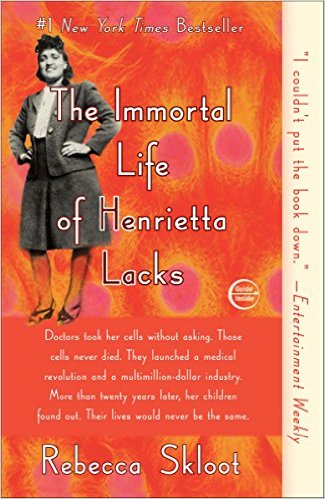
|
REVIEW
The unbelievable, yet true story of the ONLY human immortal known to exist. Henrietta Lacks cells live on today in laboratories around the world, aiding research into genetics, cancer, aging - science that could not happen. And her family was completely unaware of this. A phenomenal story!!
Read this and be amazed how a poor, uneducated, black woman has contributed more to science than she or her family could ever understand. Immortality is possible. Henrietta proves it.
SUMMARY
Her name was Henrietta Lacks, but scientists know her as HeLa. She was a poor black tobacco farmer whose cells—taken without her knowledge in 1951—became one of the most important tools in medicine, vital for developing the polio vaccine, cloning, gene mapping, and more. Henrietta's cells have been bought and sold by the billions, yet she remains virtually unknown, and her family can't afford health insurance. This phenomenal New York Times bestseller tells a riveting story of the collision between ethics, race, and medicine; of scientific discovery and faith healing; and of a daughter consumed with questions about the mother she never knew.
|
|
| 87 |
Tavris, Carol
(1) |


|

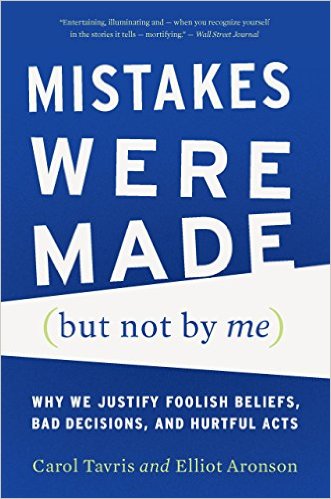
|
REVIEW
OH MY GOD... this book is down-right shocking. Not for what it presents - the fact that all humans try to reduce cognitive dissonance when ever it strikes. But for the extent to which we all delude ourselves into thinking we are rational beings. If, after reading this book, you don't begin to question every decisions, every story, every memory you've ever had... well, then you simply missed the point. THIS BOOK IS SCARY... read it if you want to be shocked at how really stupid people can think they are just brilliant.... and how really smart people can be really stupid when it comes to their own failings.
SUMMARY
Why do people dodge responsibility when things fall apart? Why the parade of public figures unable to own up when they screw up? Why the endless marital quarrels over who is right? Why can we see hypocrisy in others but not in ourselves? Are we all liars? Or do we really believe the stories we tell?
Backed by years of research and delivered in lively, energetic prose, Mistakes Were Made (But Not by Me) offers a fascinating explanation of self-deception—how it works, the harm it can cause, and how we can overcome it.
|
|
| 88 |
Toffler, Alvin
(1) |

|

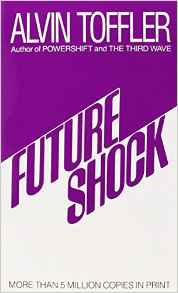
|
REVIEW
This book appeared in the 1970's and described the "shock" that people and societies where suffering from the extremely pace of change. It was a little doom and gloomy, arguing that the rapid pace of change in society would have severe negative effects. It's true that many people get left behind by change, but most people seem to adapt fairly well. And change is only happening faster and faster since this book came out. Some handle it just fine. Some suffer from "information overload" - a term Toffler invented. The book has something to say, but I think we've all lived through much of what it predicted already, so reading it now might seem like a look at slower more pastoral times. (ironic)
SUMMARY
Examines the effects of rapid industrial and technological changes upon the individual, the family, and society.
|
|
| 89 |
Trump, Mary
(1) |
|
Too Much and Never Enough: How My Family Created the World's Most Dangerous Man(History)


|

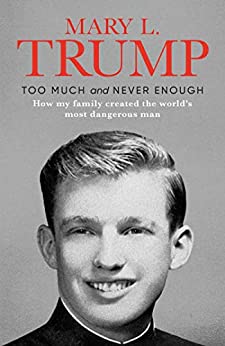
|
REVIEW
We all know what kind of man President Donald J. Trump is; he suffers from crippling narcissism and has never suffered any consequences from any actions in his life. He only cares about himself. He is only loyal to himself. But how did he get that way?
Well, Mary Trump, having grown up in the Trump family, offers an insight into the horrible way Trump was raised by Fred Trump who punished perceived failure and was completely unforgiving for any child who would not submit to his rule and seek his approval.
You could almost forgive the man for how he turned out, but the fact that he refuses to learn anything ever.. means he doesn't believe he has ever made an error or will ever need forgiveness for anything.
SUMMARY
In this revelatory, authoritative portrait of Donald J. Trump and the toxic family that made him, Mary L. Trump, a trained clinical psychologist and Donald’s only niece, shines a bright light on the dark history of their family in order to explain how her uncle became the man who now threatens the world’s health, economic security and social fabric.
Mary Trump spent much of her childhood in her grandparents’ large, imposing house in New York, where Donald and his four siblings grew up. She describes a nightmare of traumas, destructive relationships and a tragic combination of neglect and abuse. She explains how specific events and general family patterns created the damaged man who currently occupies the Oval Office, including the strange and harmful relationship between Fred Trump and his two oldest sons, Fred Jr. and Donald.
A first-hand witness, Mary brings an incisive wit and unexpected humour to sometimes grim, often confounding family events. She recounts in unsparing detail everything from her uncle Donald’s place in the family spotlight and Ivana’s penchant for regifting to her grandmother’s frequent injuries and illnesses and the appalling way Donald, Fred Trump’s favourite son, dismissed and derided him when he began to succumb to Alzheimer’s.
Numerous pundits, armchair psychologists and journalists have sought to explain Donald Trump’s lethal flaws. Mary Trump has the education, insight and intimate familiarity needed to reveal what makes Donald, and the rest of her clan, tick. She alone can recount this fascinating, unnerving saga, not just because of her insider’s perspective but also because she is the only Trump willing to tell the truth about one of the world’s most powerful and dysfunctional families.
|
|
| 90 |
Waldman, Jonathan
(1) |


|
|
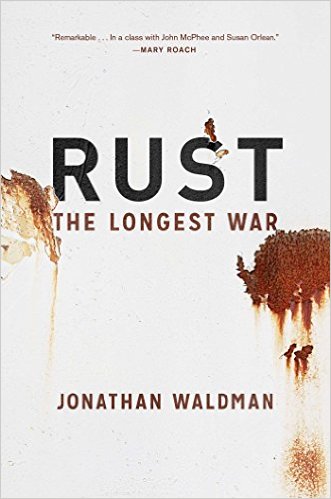
|
REVIEW
Rust never sleeps!
Truer words were never spoken. This book starts with protesters climbing the Statue of Liberty. The caretakers thought they put holes in the statue, but found that it was actually RUST!! We then follow the restoration of the statue and how it will supposedly last for another 100 years.
From there we look at Cans, and how every can has a different coating to contain everything from tomato paste to Green Battery Acid (Mountain Dew). We explore the galvanizing industry. We look into what the military is doing about corrosion (with guest appearance from Levar Burton). Rust as ART. Rust as infrastructure destruction.
Another of those one word title books (RUST, OXYGEN, PIGEON, etc) I found this to be a very interesting read.
SUMMARY
It has been called "the great destroyer" and "the evil." The Pentagon refers to it as "the pervasive menace." It destroys cars, fells bridges, sinks ships, sparks house fires, and nearly brought down the Statue of Liberty. Rust costs America more than $400 billion per year—more than all other natural disasters combined.
In a thrilling drama of man versus nature, journalist Jonathan Waldman travels from Key West, Florida, to Prudhoe Bay, Alaska, to meet the colorful and often reclusive people who are fighting our mightiest and unlikeliest enemy. He sneaks into an abandoned steelworks with a brave artist, and then he nearly gets kicked out of Ball Corporation's Can School. Across the Arctic, he follows a massive high-tech robot that hunts for rust in the Alaska pipeline. On a Florida film set he meets the Defense Department's rust ambassador, who reveals that the navy's number one foe isn't a foreign country but oxidation itself. At Home Depot's mother ship in Atlanta, he hunts unsuccessfully for rust products with the store's rust-products buyer—and then tracks down some snake-oil salesmen whose potions are not for sale at the Rust Store. Along the way, Waldman encounters flying pigs, Trekkies, decapitations, exploding Coke cans, rust boogers, and nerdy superheroes.
The result is a fresh and often funny account of an overlooked engineering endeavor that is as compelling as it is grand, illuminating a hidden phenomenon that shapes the modern world. Rust affects everything from the design of our currency to the composition of our tap water, and it will determine the legacy we leave on this planet. This exploration of corrosion, and the incredible lengths we go to fight it, is narrative nonfiction at its very best—a fascinating and important subject, delivered with energy and wit.
|
|
| 91 |
Wallace, Danny
(1) |


 |

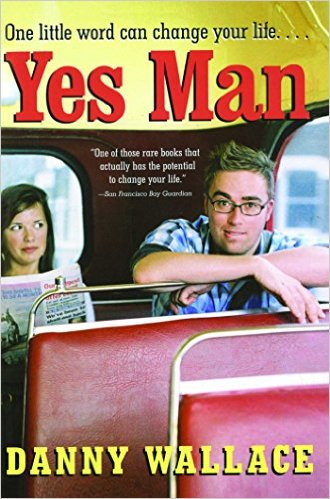
|
REVIEW
READ THIS BOOK !!! YES MAN is about the author, Danny Wallace, who, after a random encounter on a bus, decides that his life has been closed off and limited because he is saying NO too often. So for 6 months he decides to say YES to everything. And he means EVERYTHING. This book tells of his adventures and mishaps; his ups and downs; the effect the world of YES has on him, and the effect his YESing has on those around him. In the end he faces a major crisis, and a major opportunity, and YES prevails. It had me in tears. READ THIS BOOK - it will make you laugh and it will make you think.
SUMMARY
Recently single, Danny Wallace was falling into loneliness and isolation. When a stranger on a bus advises, "Say yes more," Wallace vows to say yes to every offer, invitation, challenge, and chance.
In Yes Man, Wallace recounts his months-long commitment to complete openness with profound insight and humbling honesty. Saying yes takes Wallace into a new plane of existence: a place where money comes as easily as it goes, nodding a lot can lead to a long weekend overseas with new friends, and romance isn't as complicated as it seems. Yes eventually leads to the biggest question of all: "Do you, Danny Wallace, take this woman . . ."
Yes Man is inspiring proof that a little willingness can take anyone to the most wonderful of places.
|
|
| 92 |
Wansink, Brian
(1) |


|

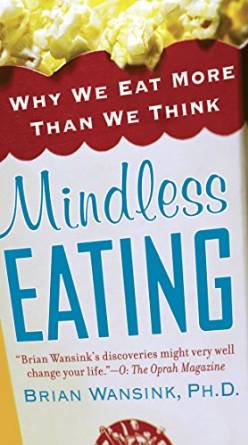
|
REVIEW
If you are trying to lose a little weight, this is the absolute best book in the world. The reason you gain weight is that you eat more calories than you need. But why do you do that? Especially when, if you didn’t eat those few extra calories, you wouldn’t miss em anyway. This book is about the psychology of food and eating. Wansink runs a nutrition laboratory where he does experiments to discover what will make people eat more and what will make people eat less. These are fascinating. Some examples…. - This book is about the psychology of food and eating. Wansink runs a nutrition laboratory where he does experiments to discover what will make people eat more and what will make people eat less. These are fascinating. Some examples….
- People will eat more snacks at a party if those snacks are split into many smaller bowls than if they are presented in one large bowl each. Why? Because they get a false sense of variety and so consume more. - If you want to keep candy at your desk, put the bowl 6 feet away on
- If you want to keep candy at your desk, put the bowl 6 feet away on a filing cabinet. You will automatically consume 20% less. Why? Because the act of getting up to get a few more will give you a natural pause point that allows your brain to kick in and say, “Do I really want this?”
This book will give you plan for a diet that doesn’t involve changing what you eat, but the way you eat it. Diets that make you feel deprived will not work. But the hints in this book will trick you into eating less without your even consciously noticing it. And the writing style is just plain entertaining… the experiments are fun. You will have lots of AH-HAH moments reading this one.
This book will literally change the way you think about your next meal. Food psychologist Brian Wansink revolutionizes our awareness of how much, what, and why we’re eating—often without realizing it. His findings will astound you.
• Can the size of your plate really influence your appetite?
• Why do you eat more when you dine with friends?
• What “hidden persuaders” are used by restaurants and supermarkets to get us to overeat?
• How does music or the color of the room influence how much—and how fast—we eat?
• How can we “mindlessly” lose—instead of gain—up to twenty pounds in the coming year?
Starting today, you can make more mindful, enjoyable, and healthy choices at the dinner table, in the supermarket, at the office—wherever you satisfy your appetite.
SUMMARY
This book will literally change the way you think about your next meal. Food psychologist Brian Wansink revolutionizes our awareness of how much, what, and why we're eating—often without realizing it. His findings will astound you.
• Can the size of your plate really influence your appetite?
• Why do you eat more when you dine with friends?
• What "hidden persuaders" are used by restaurants and supermarkets to get us to overeat?
• How does music or the color of the room influence how much—and how fast—we eat?
• How can we "mindlessly" lose—instead of gain—up to twenty pounds in the coming year?
Starting today, you can make more mindful, enjoyable, and healthy choices at the dinner table, in the supermarket, at the office—wherever you satisfy your appetite.
|
|
| 93 |
Wright, Robert
(1) |


|

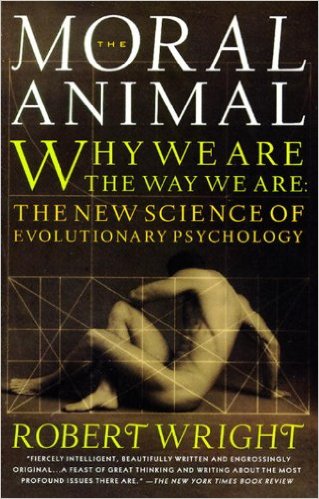
|
REVIEW
This is one of the best books on Evolutionary Psychology that I've come across so far. It uses an interesting approach to examine the various predictions that Evol. Psych. can make; it examines the life of Charles Darwin in particular and Victorian English Morality in general to see how that life and that societies morals fit with the Evolutionary Psychological view of how humans would normally behave.
Are men literally born to cheat? Does monogamy actually serve women's interests? These are among the questions that have made The Moral Animal one of the most provocative science books in recent years. Wright unveils the genetic strategies behind everything from our sexual preferences to our office politics--as well as their implications for our moral codes and public policies. Illustrations.
SUMMARY
Are men literally born to cheat? Does monogamy actually serve women's interests? These are among the questions that have made The Moral Animal one of the most provocative science books in recent years. Wright unveils the genetic strategies behind everything from our sexual preferences to our office politics--as well as their implications for our moral codes and public policies. Illustrations.
|
|





































































































